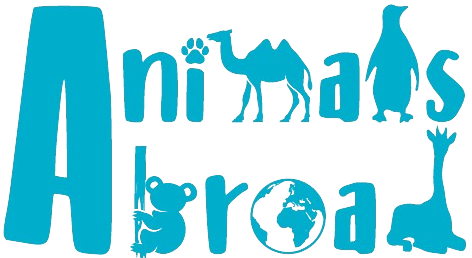Over our 51-day self-drive safari through South Africa, Namibia, Botswana, and Zambia, we camped at more than 30 sites, each offering charm, quirks, and surprises. With our camper truck from South Africa 4×4 and two rooftop tents, we were well-equipped for life on the road.
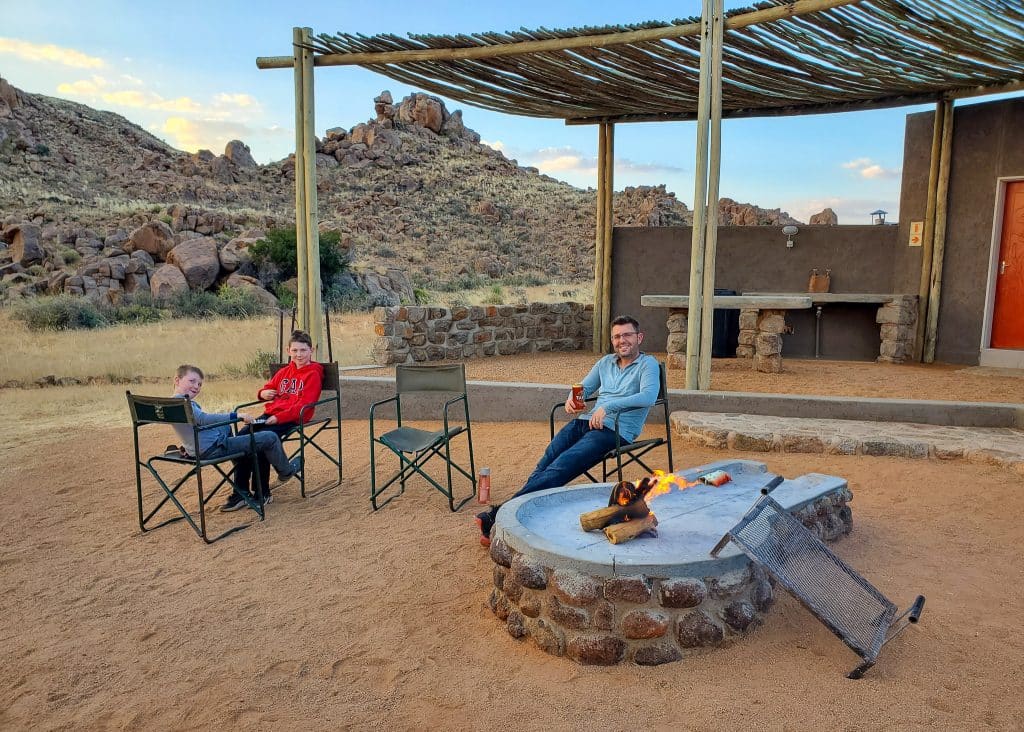
One of the things we enjoyed most was the element of surprise. Since our rental company booked all the campsites, we never looked them up in advance. Each day, we’d punch the next stop into the GPS and wonder what we’d find. Some had pools, shops, or wildlife walking through. Others were more basic—sometimes very basic. It became a daily guessing game, and part of the fun.
But we know not everyone loves that kind of mystery. So if you’re planning your own overland safari or want to know what to expect, this post is for you. We’ve pulled together a quick rundown of the campgrounds we stayed at—what we liked, what didn’t work so well, and what might matter most if you’re travelling with kids.
For more practical tips on embarking on your first safari, check out: Camping Safari in Africa: Know Before You Go
South Africa
Strandfontein Karavaanpark en Chalets, Vredendal
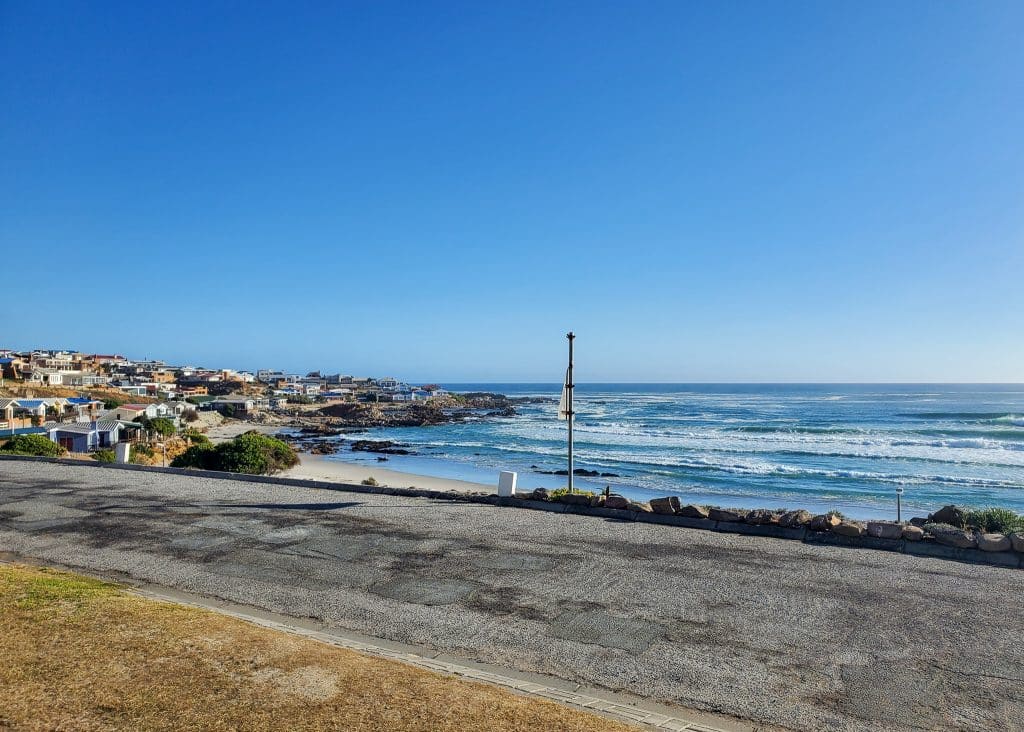
Strandfontein Karavannpark en Chalets offered oceanfront campsites with private ablution facilities, including hot showers. Sites with shared facilities and cabins were also available. No fire pit, but power and water were available on the site. No Wi-Fi.
Delwerskamp & Boulder Bay Campgrounds, Namaqua National Park
These campsites were two of our trip’s most peaceful and breathtaking campsites. Sitting oceanside, the circular-shaped stone wall surrounding the fire pit was the perfect place to escape the wind and cook a hot meal.
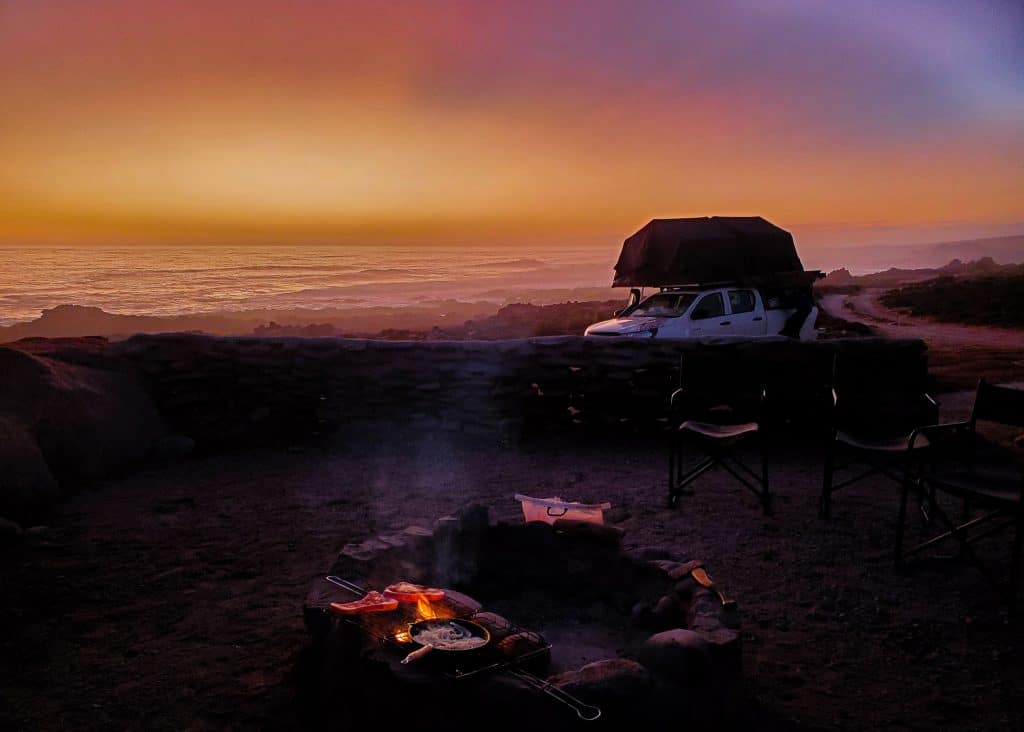
Delwerskamp & Boulder Bay were extremely basic campsites, with clean outhouses and only brackish water available. You must bring your own water supply to cook and drink. No Wi-Fi.
The campgrounds are within Namaqua National Park, so there’s an additional park fee on top of the campground fee.

Driving Time: 1-hour drive within the park.
Roads: Soft sandy roads required four-wheel drive and decreased tire pressure to navigate.
Namibia
Namibia has an extensive network of campgrounds called Namibia Wildlife Resorts (NWR). These are easy to access and offer amenities such as showers, restaurants, cabins, and laundry services, to name a few. However, with this comes higher prices and large crowds. Although we enjoyed the services, we preferred the smaller campgrounds for their serene atmosphere.
Hobas Campground (NWR), Fish River Canyon National Park
The Hobas NWR sites included running water, electricity and shared ablution facilities. However, they were close together, limiting privacy. The campground had a pool and a restaurant. Upgrades to cabins were available, and good Wi-Fi was available at reception.
Hobas is located within Fish River Canyon National Park therefore additional park fees are in effect.
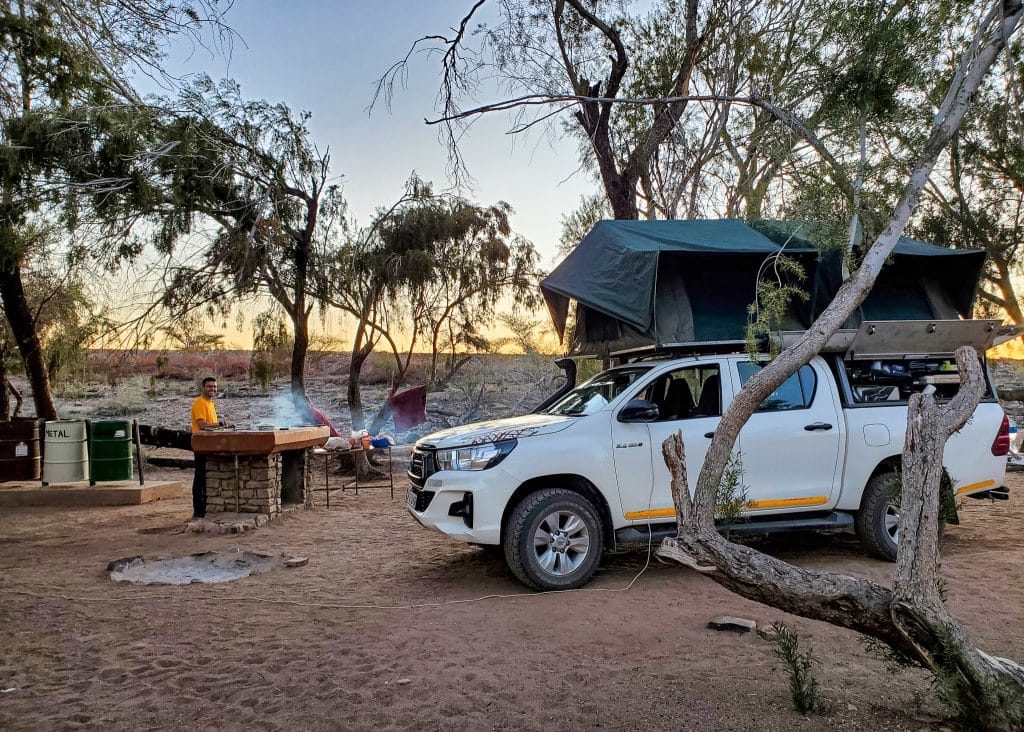
Safety Tip: Be cautious of baboons! They are not frightened by humans and can be aggressive. We witnessed one boldly snatch a loaf of bread off a neighbouring camper’s table with three grown men sitting at it.
Ais-Ais Hot Springs and Spa (NWR), Ais-Ais
This beautiful campground is set in a stunning valley surrounded by towering copper mountains. The outdoor pool, heated by nearby hot springs, is perfect for little ones. The onsite hot springs, however, have water temperatures of 65°C (149°F), far too hot to soak in.
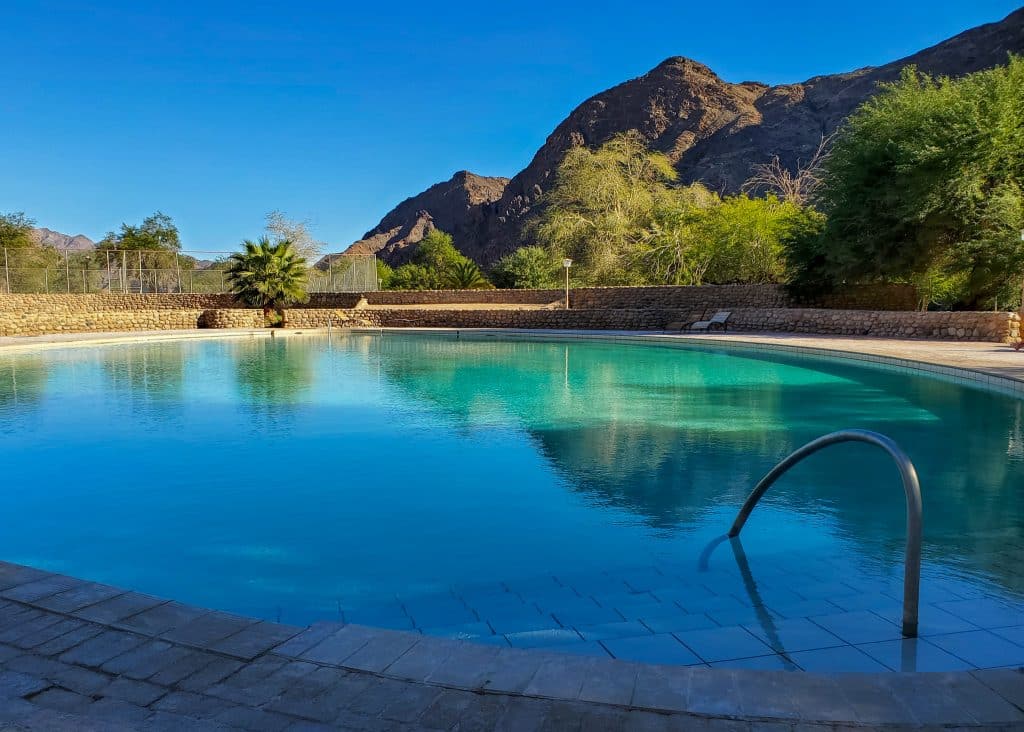
Ai-Ais Hot Springs and Spa Resort has a spacious grassy area in the centre of the campground divided into several campsites. Several shared fire pits, kitchen areas, and ablution facilities are scattered throughout the resort, as well as a variety of accommodations, from campsites to hotel rooms. Restaurant and laundry service were available. There was poor Wi-Fi at reception.
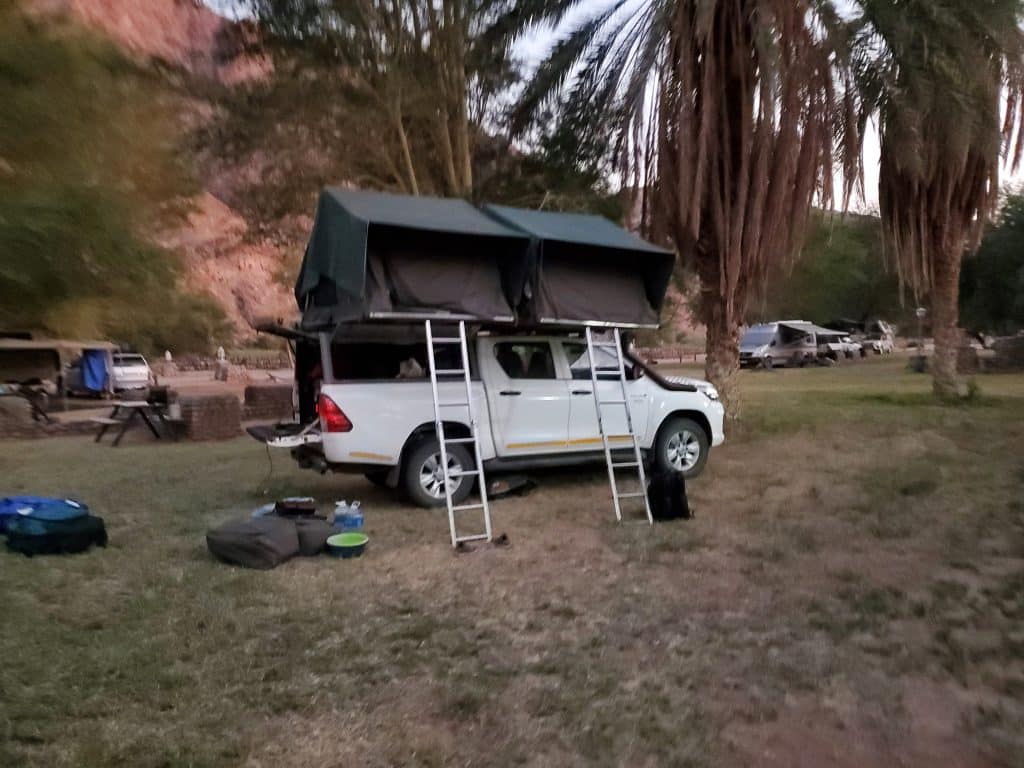
Tip: If we were to stay in the area again, we would book at Ais-Ais Hot Springs and Spa and drive the hour to Fish River Canyon National Park rather than staying at Hobas. It is a far nicer campground and you skip the addtional National Park fee as Ais-Ais Hot Springs and Spa is located outside Fish River Canyon.
Landsberg Farm, near the town of Helmeringhausen
This family-run campground, located off the beaten path, became one of our favourite stops. Reaching it required a long stretch of off-roading, but it was worth every bump. With only four campsites, we felt completely immersed in nature. Although remote, the amenities were luxurious.
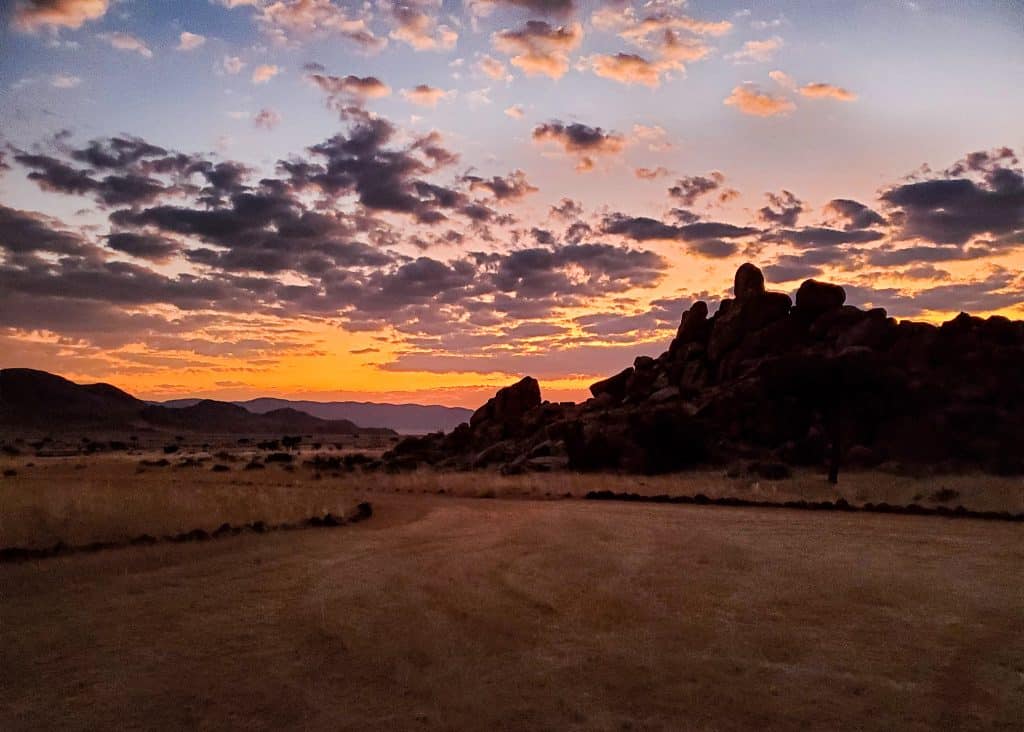
Landsberg Farm Campground was located on a 16,000-hectare working farm. Sites feature private showers, toilets, outdoor sinks, fire pits, and hot water on demand. Wi-Fi was available for a small fee, but the signal did not reach the campsites.
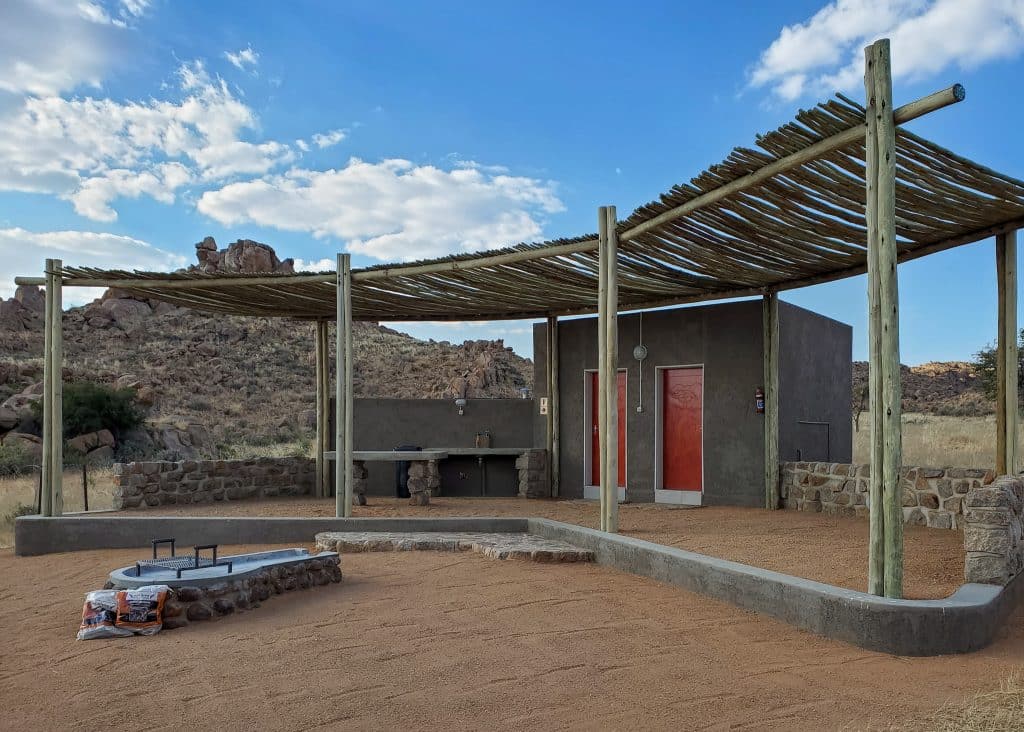
Sesriem Campground (NWR), Sossusvlei National Park
Sesriem Campground was one of the more underwhelming NWRs. Campsites were moderately spaced, with a single large tree offering shade but little privacy between sites. Shared ablution facilities were understocked and dirty. Upgrades to cabins were available, and there was a restaurant on-site. Wi-Fi was available for a fee.
Tip: The Sesriem NWR is inside Sossusvlei National Park, meaning an additional National Park fee applies. The NWR was overpriced for what it offered. We recommend staying at a site outside the park for better value.
Naukluft Campground (NWR), Naukluft National Park
Naukluft National Park is a well-known hiking destination with several mountain trails starting from the reception area. However, baboons frequent the campground and the trails. We were advised not to leave our tents up when we weren’t around, as the baboons were skilled at tearing tents apart and rummaging inside!
Naukluft Campground is set in a mountain range, meaning it can be chilly in winter. The temperature drops to -2°C (28°F) overnight during our stay. There are cabin upgrades, but they are not heated. .
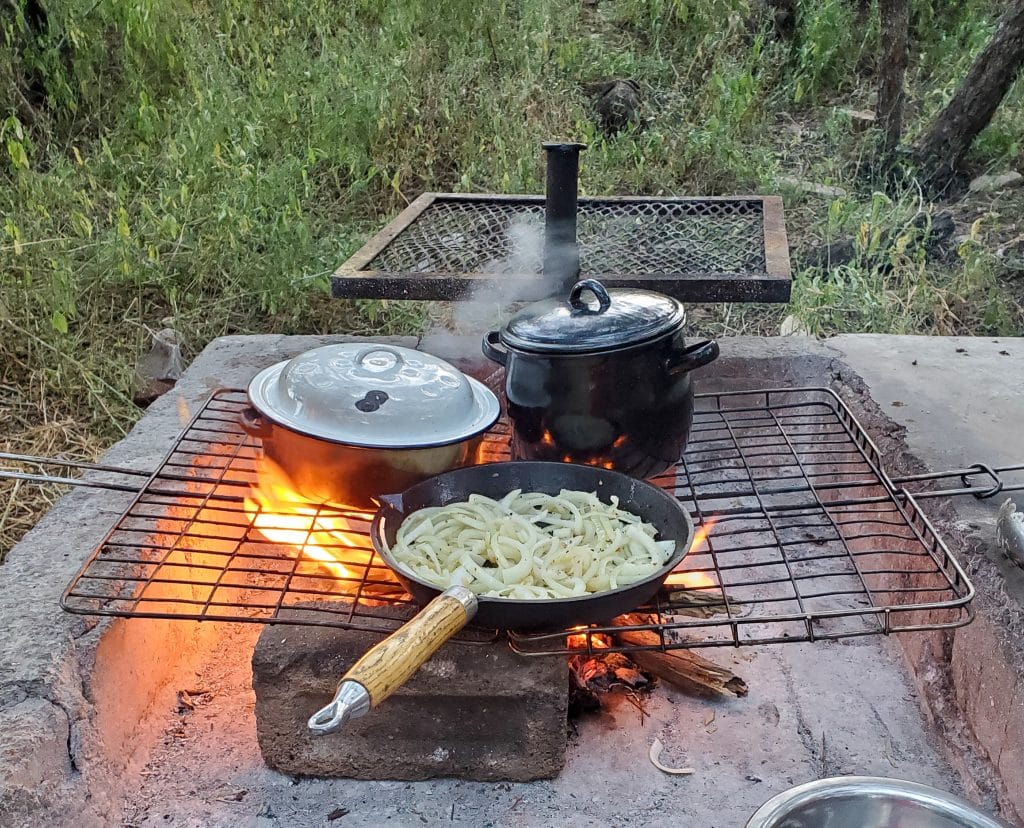
The campsites were close together and shaded by trees. Despite the number of trees, they offered little privacy. Shared ablution and kitchen facilities, along with a restaurant, were available. Wi-Fi was available at reception.
Alte Brucke Resort, Swakopmund
Alte Brucke Resort is within walking distance of the beach and the famous Swakopmund jetty, and it is close to grocery stores, banks, and gas stations, making it a great place to stock up on essentials. The town offers plenty of adventure activities, such as Cape fur seal kayaking tours to Walvis Bay.
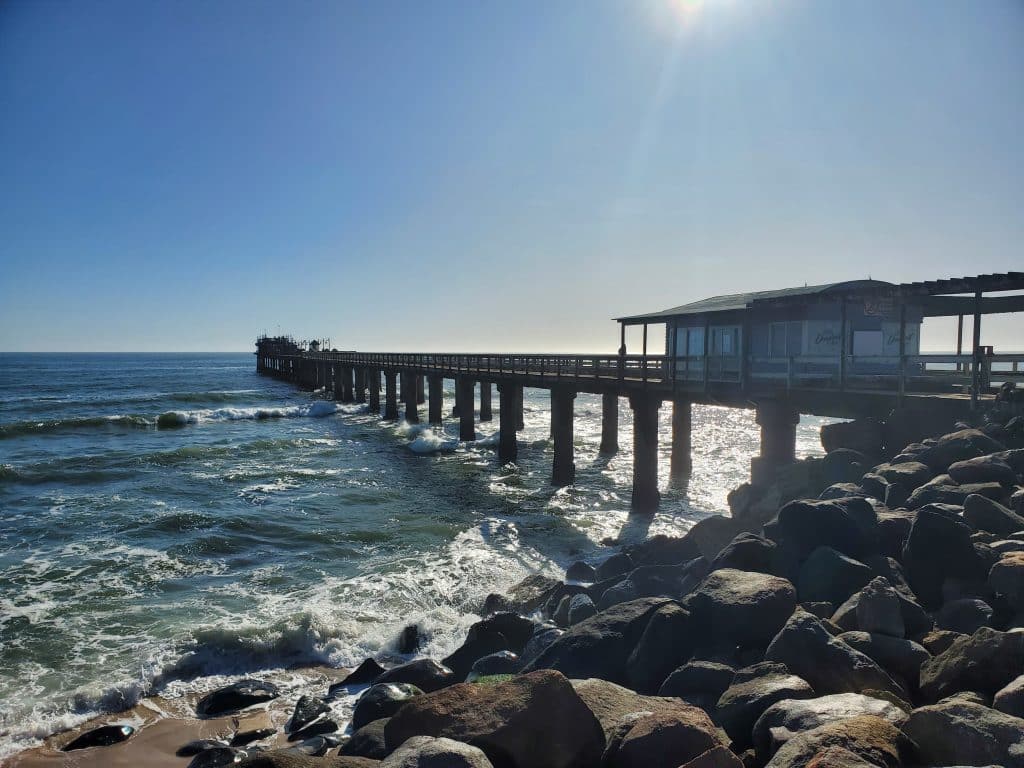
Alte Brucke Resort campsites were close together but separated by half-stone walls, allowing for some privacy. Each site had power, water, a private bathroom/shower, a covered patio, a fire pit and chimney, an outdoor sink, and a concrete prep counter. There was a grassy area to set up campers or tents. Wi-Fi reached the campsites. Cabins and a restaurant were also available.
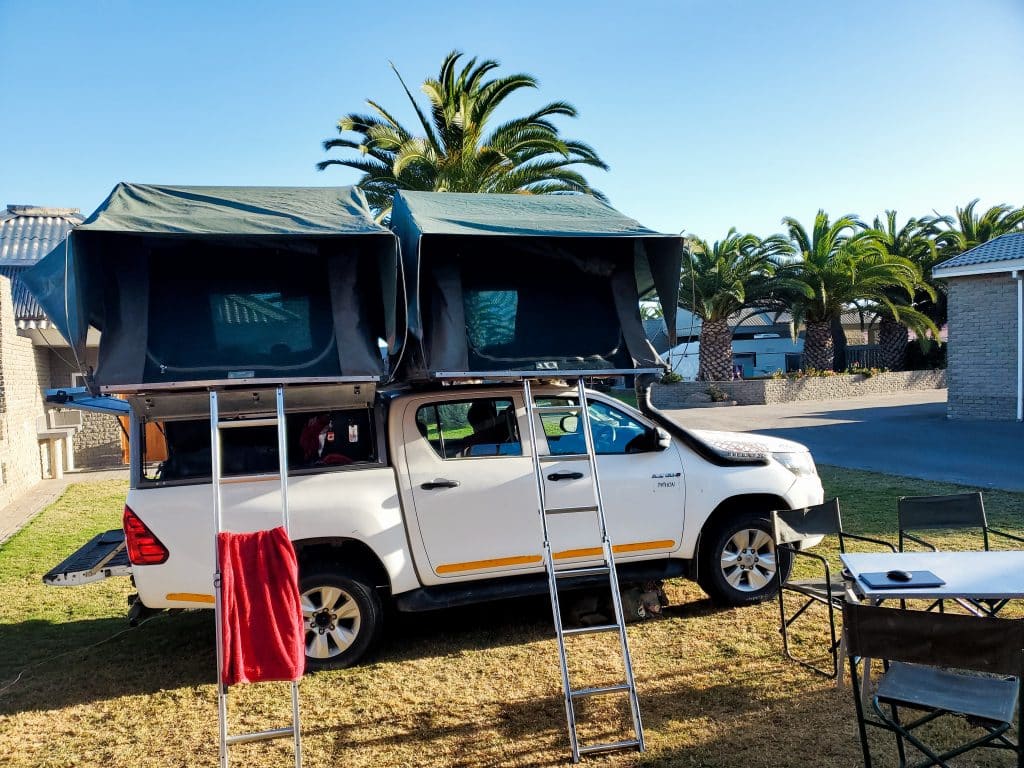
Mile 108 Campground, Skeleton Coast
We loved the serenity of the Mile 108 campground—the calmness and quiet. The only sounds were the waves crashing, the crackling fire, and the boys’ laughter as they played on the beach. It was grey and foggy when we arrived, so we spent most of the afternoon huddled around the fire, enjoying homemade s’mores.
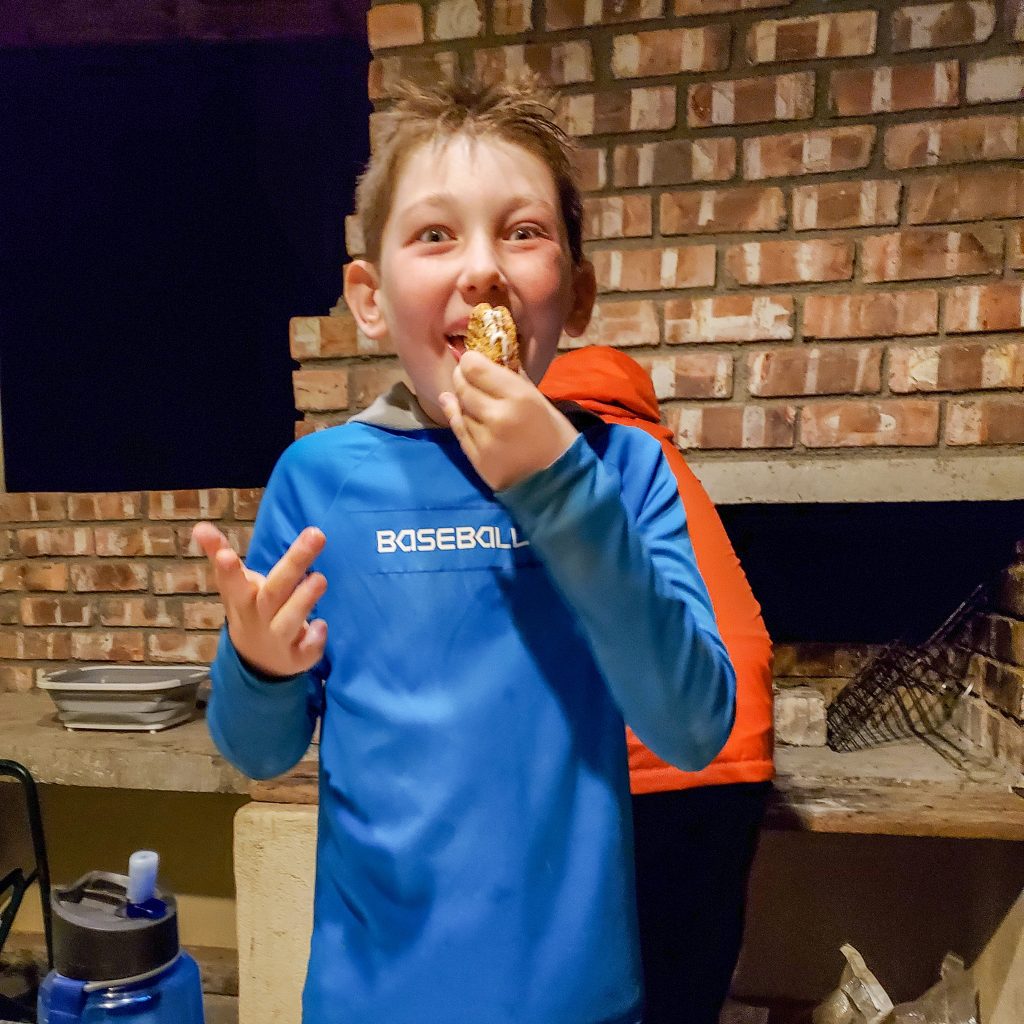
Mile 108 campground is located on the beach next to the Atlantic Ocean. During our stay, the weather was mild, with a heavy mist coming off the ocean that made everything damp. Since there were so few people, the manager gave us a free upgrade to a site with a private bathroom/shower and a covered patio with an enclosed fire pit. This upgrade made a huge difference because the wind picked up in the evening, and we may not have been able to get a fire going with an open fire pit. We only saw one other camper during the low season, but privacy might be an issue during peak season since the campsites were quite close together.
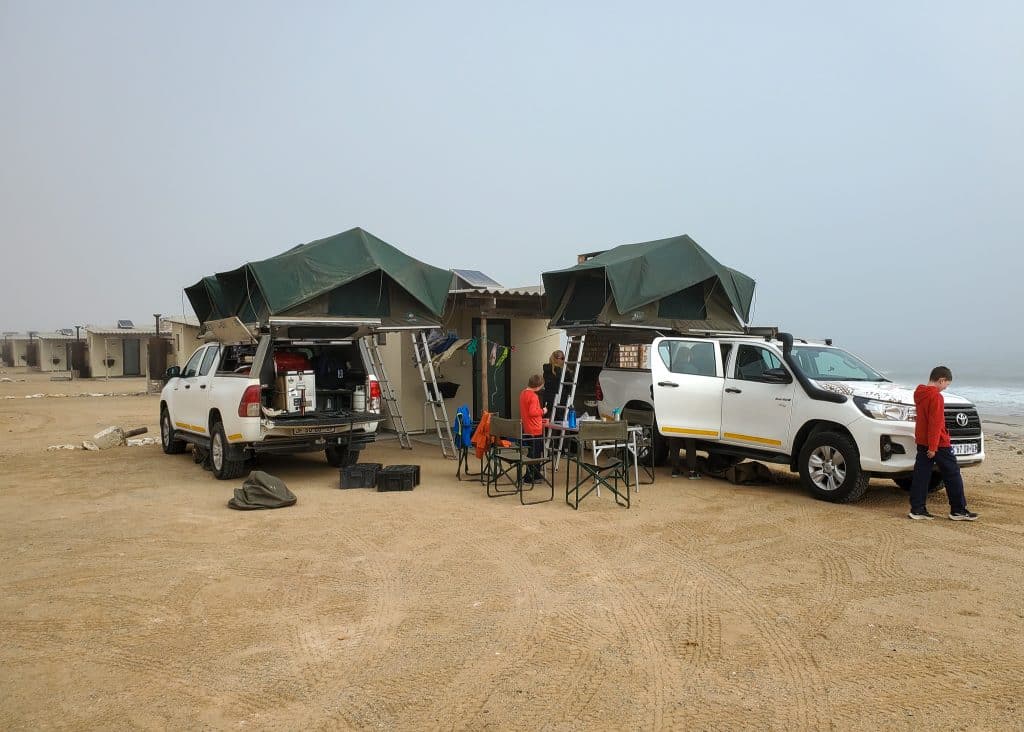
Madisa Campground, near Uis
Madisa Campground is the perfect place to stop on route to Twyfelfontein (18km away). There you will find some incredible attractions, including Burnt Mountain, the Organ Pipes, the Petrified Forest, and Indigenous rock art.
Madisa was one of our favourite campgrounds because of its unique charm. The campsite had a rustic feel, with a private open-air bathroom and shower and large leafy trees that provided ample shade and privacy. Once the sun set, we were mesmerized by the millions of sparkling stars that filled the sky—one of the best night skies we’ve ever seen.
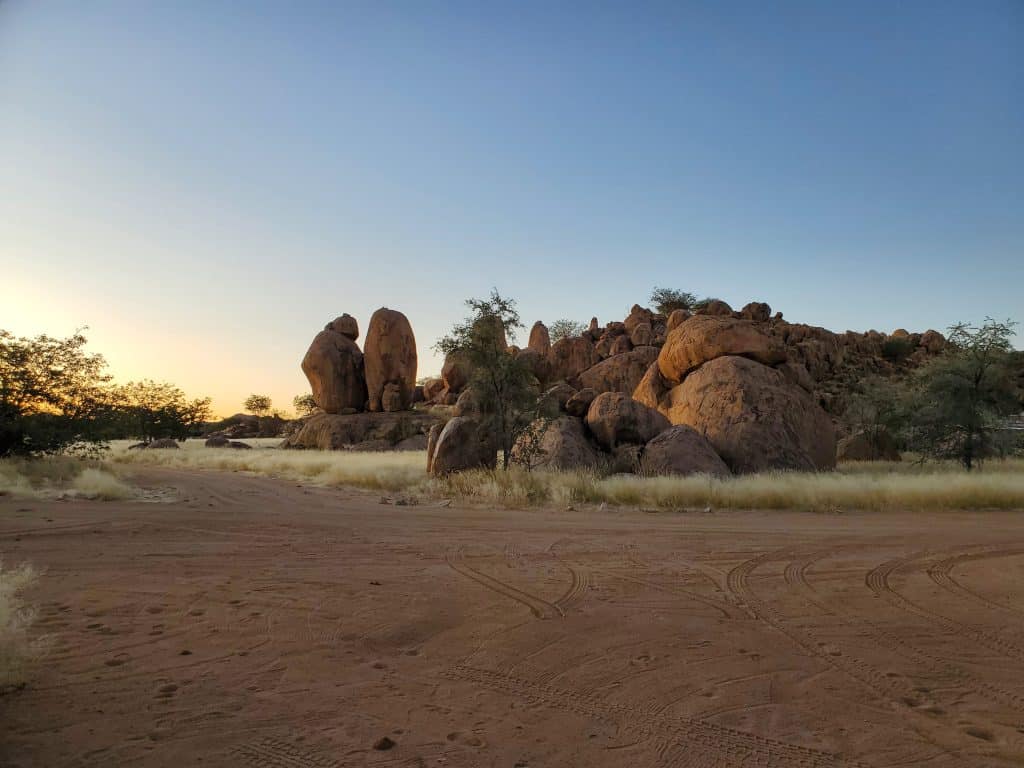
The spacious campsite at Madisa had a large fire pit for cooking, an outdoor sink, a prep area, and hot water from a fire source. Power for charging electronics was available but not for camper hook-up, and a small light was placed on a low-hanging tree branch. A bar at reception sold cold beverages, and the owner offered group hikes to watch the sunset. No Wi-Fi.
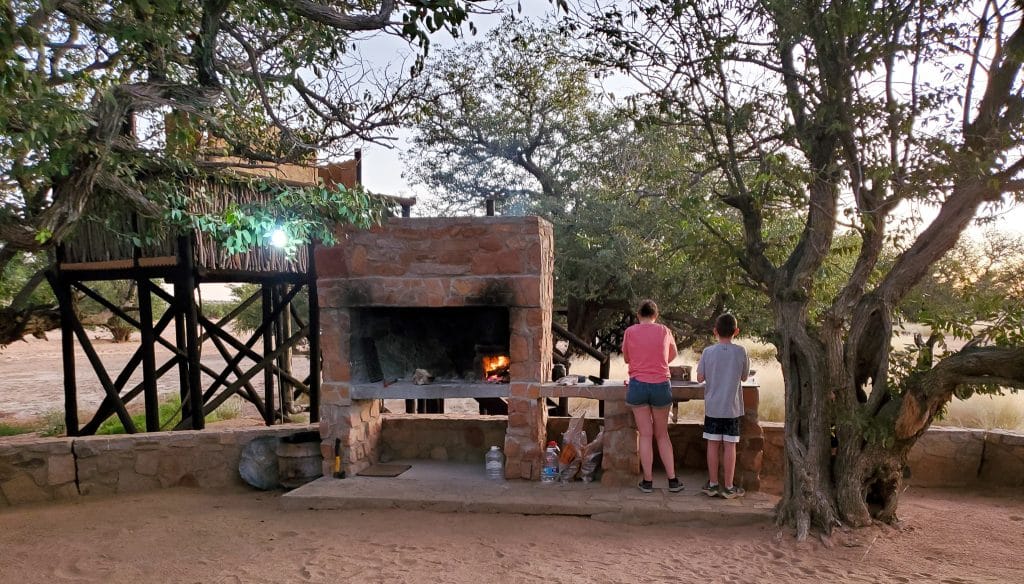
Ongongo Waterfall Campground, near Palmwag and Sesfontein
We stayed in a luxury campsite at Ongongo Waterfall Campsite, which included a private open-air bathroom and shower. The sites were spaced nicely, with brick barriers on either side and large leafy trees providing shade and privacy. The fire pit was located next to the covered patio. No power was on-site, and hot water came from a fire source. No Wi-Fi.
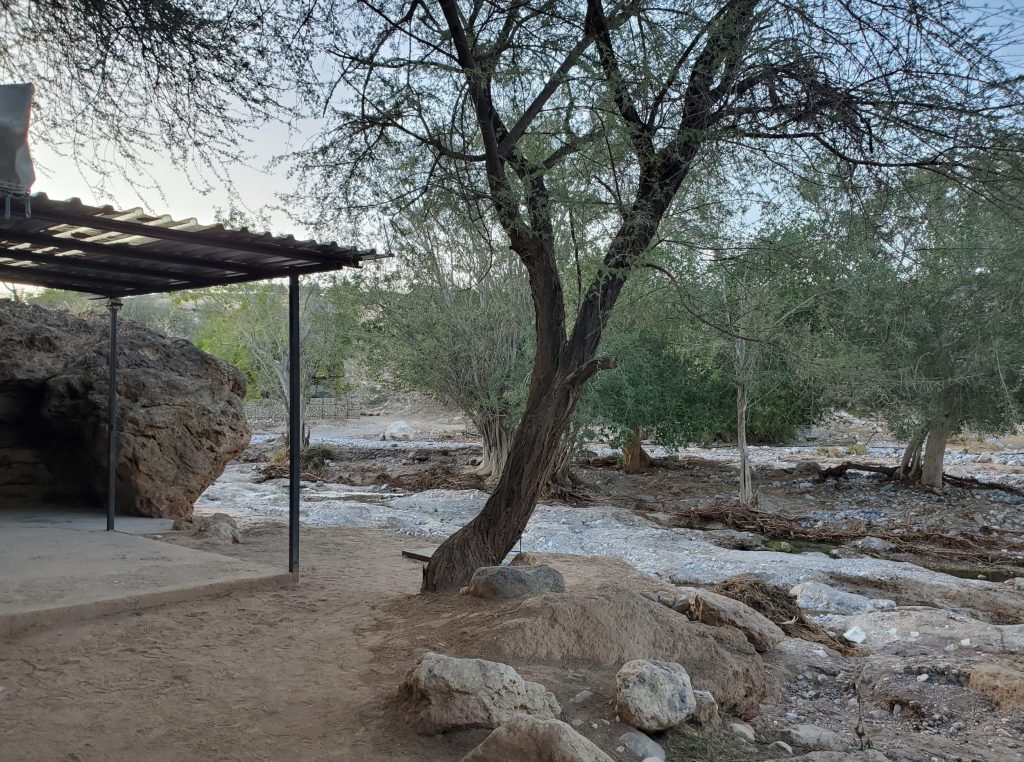
A short walk along the stream will take you to a cool, clear pool. Perfect for swimming or dipping your feet in after a long drive. Kids will love and jumping off the rocks into the deep water. Grab some drinks and head down for a refreshing afternoon.
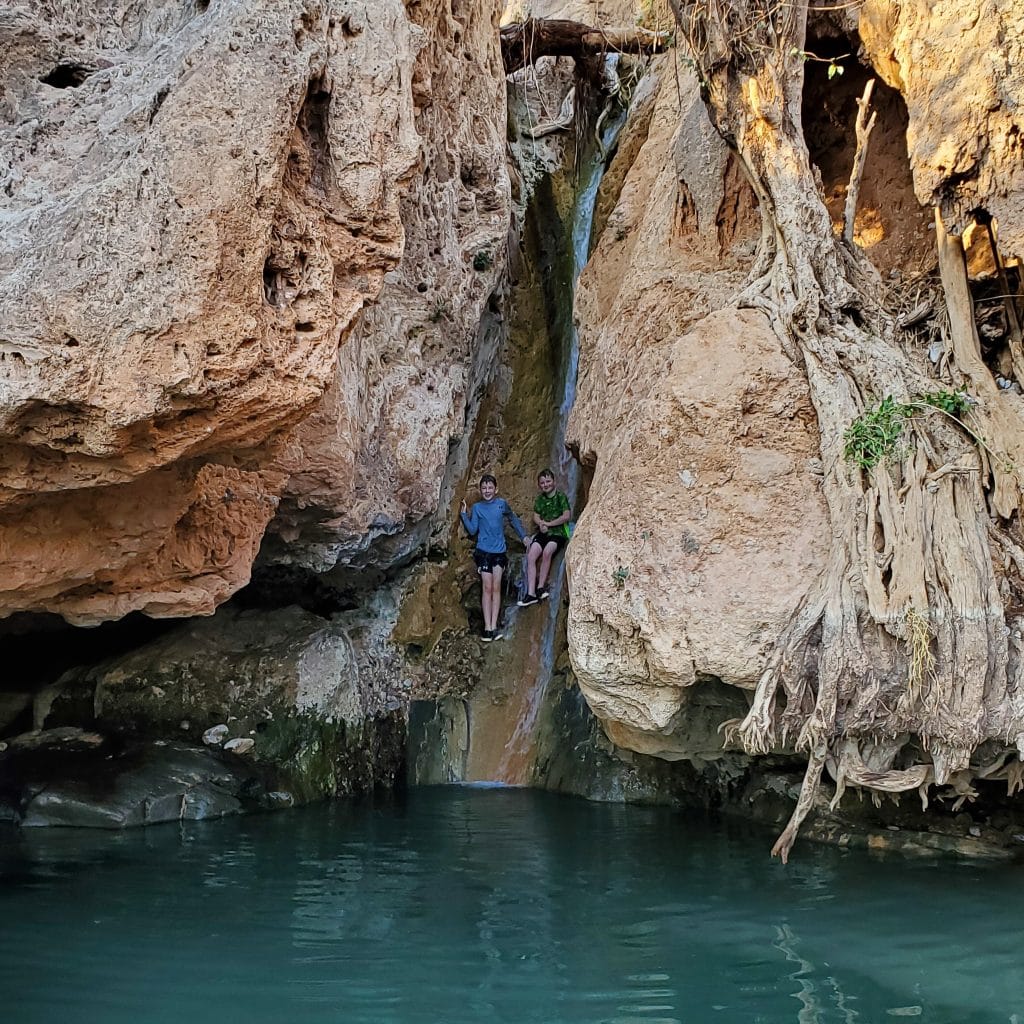
Okaukuejo, Halali & Namutoni Campgrounds in Etosha National Park
Etosha National Park is one of the best game-viewing parks in Namibia. Covering over 22,000 square kilometres, it’s worth booking at least three nights to explore the different areas.
While there, we stayed at Okaukuejo, Halali, and Namutoni campsites. Each morning, we’d pack up and slowly drive to the next campsite, scanning the terrain for wildlife along the way.
Learn More: Etosha NP with Kids: A Family Safari to Remember
Camping in Etosha
Okaukuejo/Halali/Namutoni campgrounds are like other NWR campgrounds: full of amenities but busy and cramped, offering little to no privacy. Shared kitchens and ablution facilities were available. Halali had the best showers with hot water. Power was available on-site. Wi-Fi was available for a fee. For those concerned about wildlife, the campgrounds were fence. Additional park fees apply.
But the real reason you want to stay in the campgrounds within the park is access to lit watering holes, where, during the dry season, animals gather to cool off and drink. Dawn and dusk are prime times for game sightings, and we had some of our best encounters during these hours.
Okaukuejo Campground
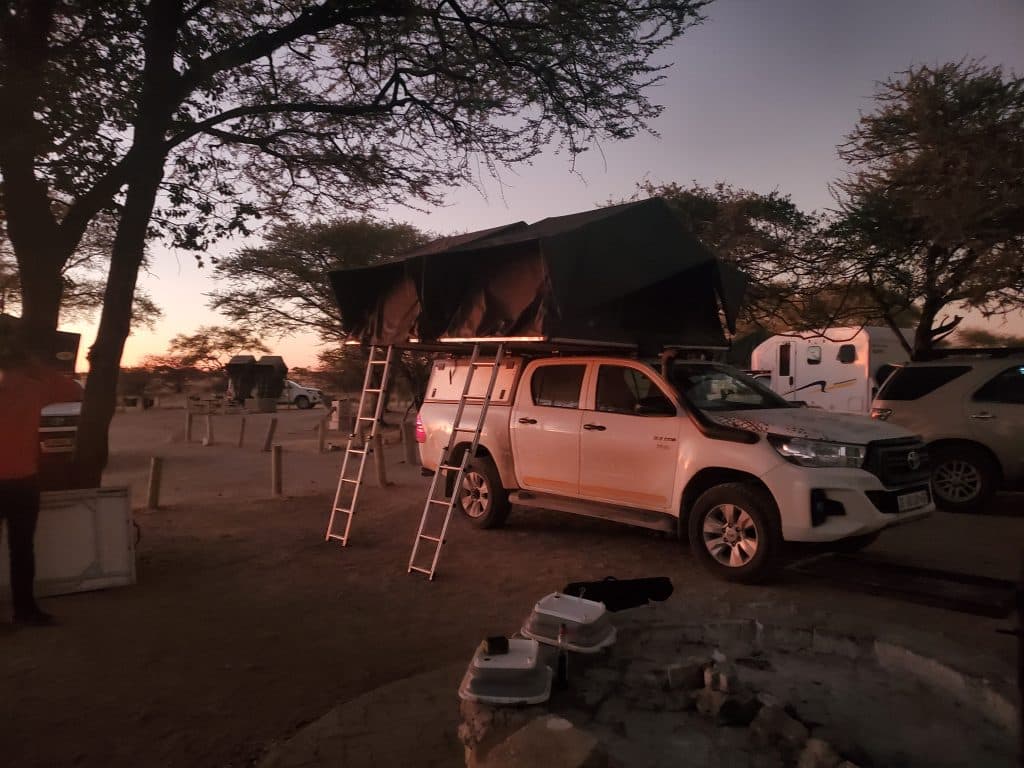
Okaukuejo Waterhole was by far the best for proximity to the animals and sightings. It’s a must-visit if you’re in the area.
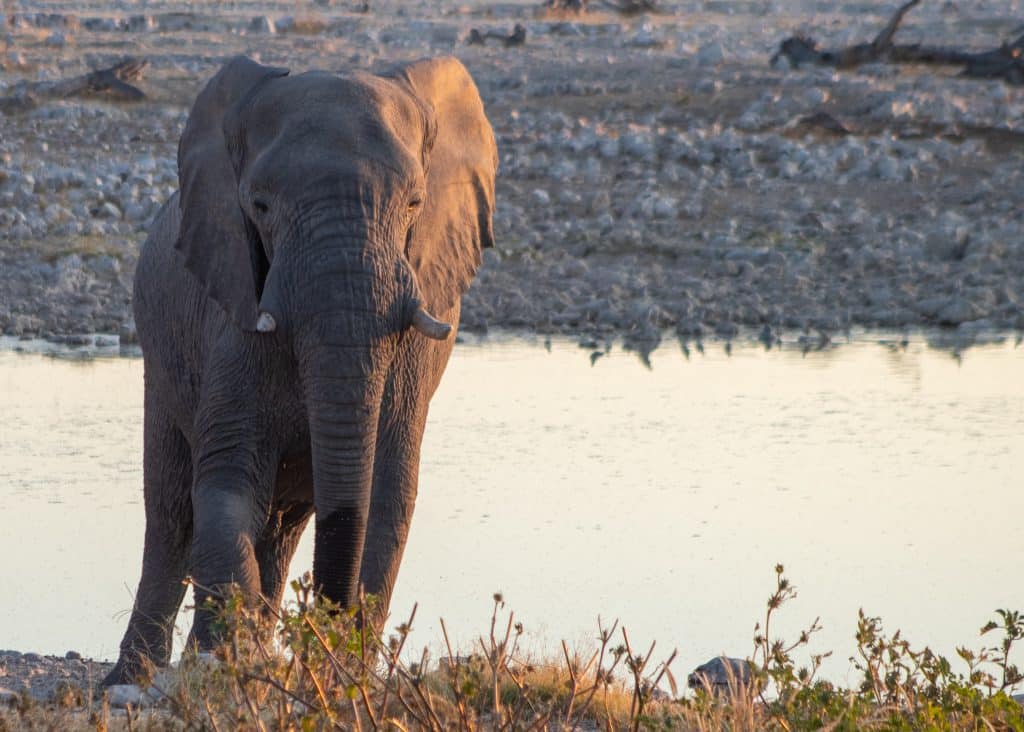
Halali Campgroud
Halali’s Waterhole also offered great viewing opportunities. The seating area was rustic, with large boulders carved into seating and trees supporting a covered patio.
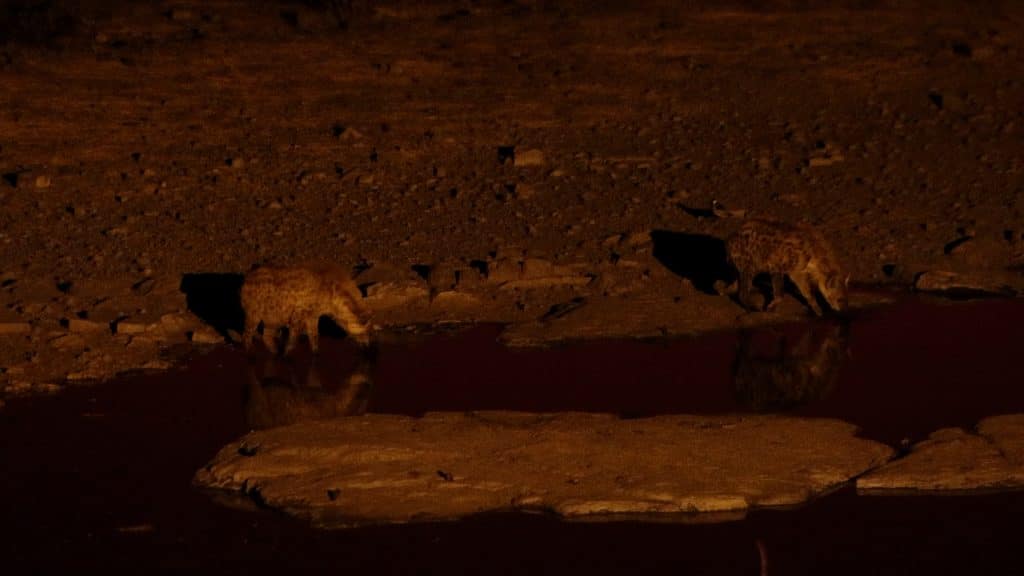
Namutoni Campground
Namutoni welcomed us with a curious gang of banded mongooses. Dozens of them zipped under the truck and darted around the campsite, digging for bugs and generally causing an amusing ruckus. They didn’t come too close and scattered with a loud clap—but it was an unexpectedly warm welcome.
Namutoni’s Waterhole was disappointing. The pond was set so far from the viewing area that it was challenging to identify animals without binoculars.
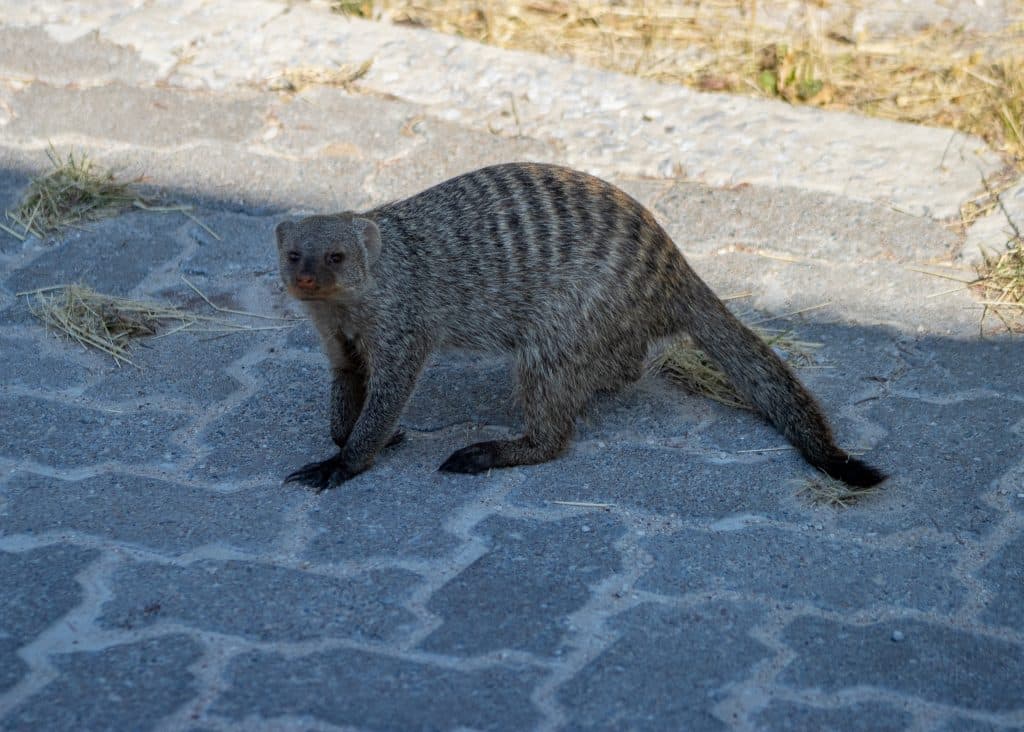
Okonjima Nature Reserve
Known for its luxury accommodations and incredible wildlife, we were all excited about our stay at Okonjima Nature Reserve. This family-owned, full-service resort offers package deals unlike other parks we’ve visited. Self-driving is not allowed here; guides must accompany guests on game drives. The reserve offers a range of activities, including hiking, day and night game drives, animal-specific tracking tours (for pangolins, rhinos, and leopards), and a fascinating education center.
Learn More: Okonjima Family Safari: Where the Wild Things Wait
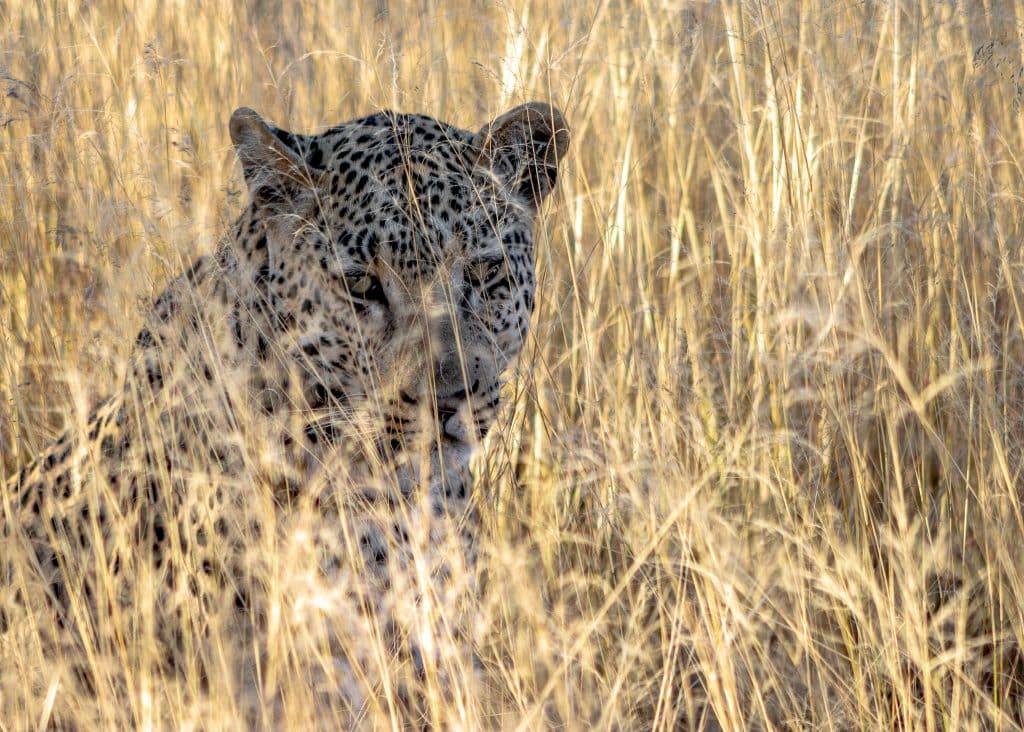
Okonjima Nature Reserve, Chilala Campsite, offered a serene and private experience with just four campsites nestled within the reserve. Each spacious campsite had a large, covered patio, power source, fire pit, complimentary firewood, and private open-air ablution facilities. The campsites were fenced off the main reserve area, but small animals like cape hares and antelopes roam freely. While there is no guarantee that large animals and predators won’t wander through the campsite, the experience is unique and intimate. A communal pool was available for campers within a short walking distance, and Wi-Fi was accessible at the reception.
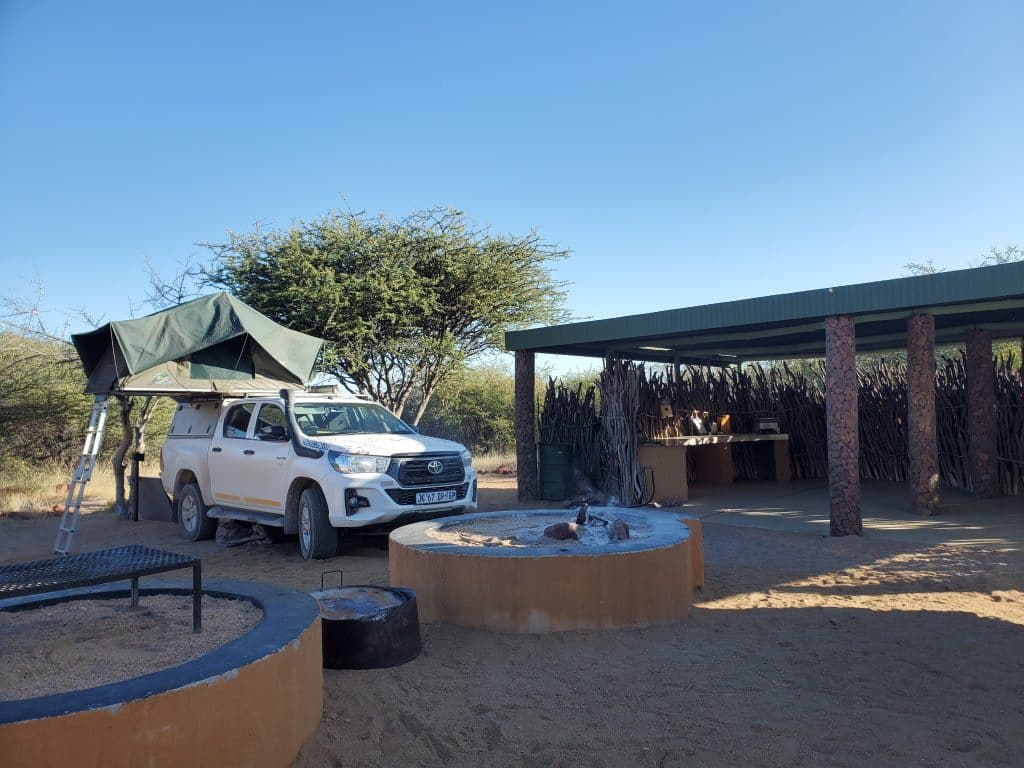
Ghaub Campground, Grootfontein
This picturesque campsite overlooked a stunning mountain range and valley. The multi-level site featured a grassy area below, perfect for parking campers or setting up tents, and an upper level with a covered patio, a large cement table seating up to twelve, a fire pit, and an outdoor washing sink. At the back of the building, you’ll find two bathrooms equipped with showers. Hot water came from a fire source. Power was available on-site, and Wi-Fi was accessible at reception, a 5-10 minute walk from the campsite.
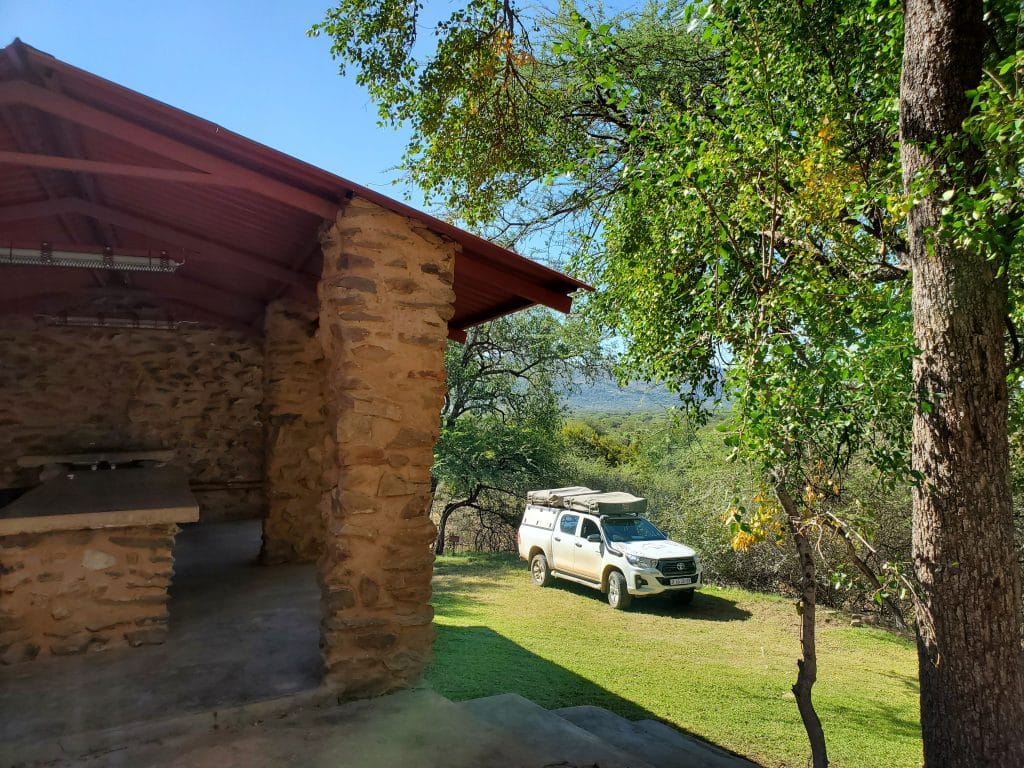
Ghaub Campground was a quick stop as we made our way east to the Caprivi Strip. We were delighted by the serene campsite on arrival, but little did we know we were in for a long night!
Learn why we later dubbed Ghaub campground the “Baboon Site.”
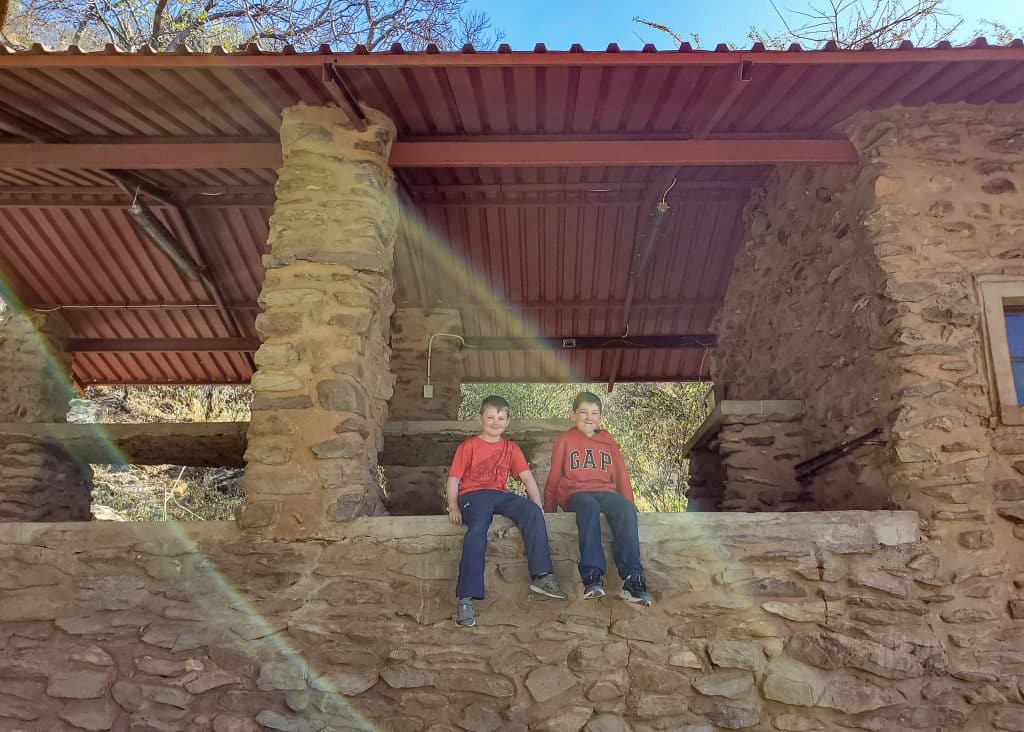
Kaisosi River Lodge, Rundu
The Kaisosi River Lodge borders Angola and Namibia, separated by the Kavango River. The lodge features a large outdoor deck perfect for enjoying the river, with the possibility of spotting hippos.
In addition to the scenic views, there were plenty of kid-friendly activities for the boys. The lodge included a restaurant, a games room with a pool table and foosball, and various outdoor amenities like a pool, trampoline, swings, tetherball, and mini golf. Kids will think they have arrived at a summer camp!
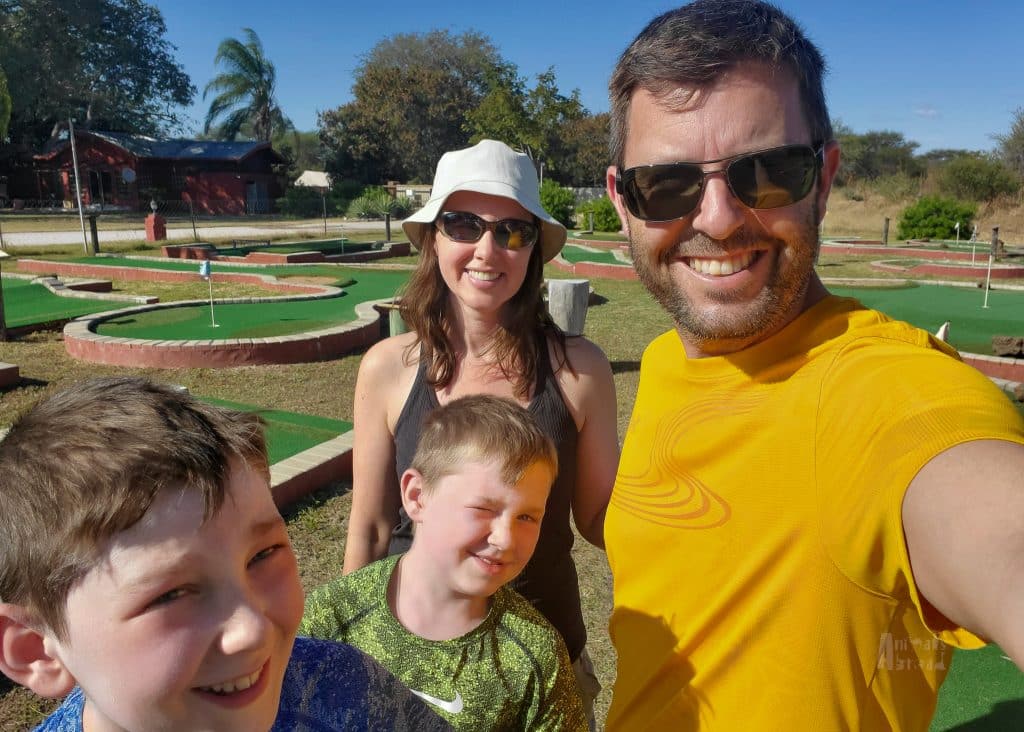
Typically, Kaisosi River Lodge wouldn’t be our favourite campground due to the proximity of campsites and lack of privacy. However, the amenities more than made up for it. The individual campsites had power and lights, a private bathroom with a shower (hot water on demand), an outdoor wash sink, and a fire pit. Wi-Fi was included, and reached the campsite intermittently.
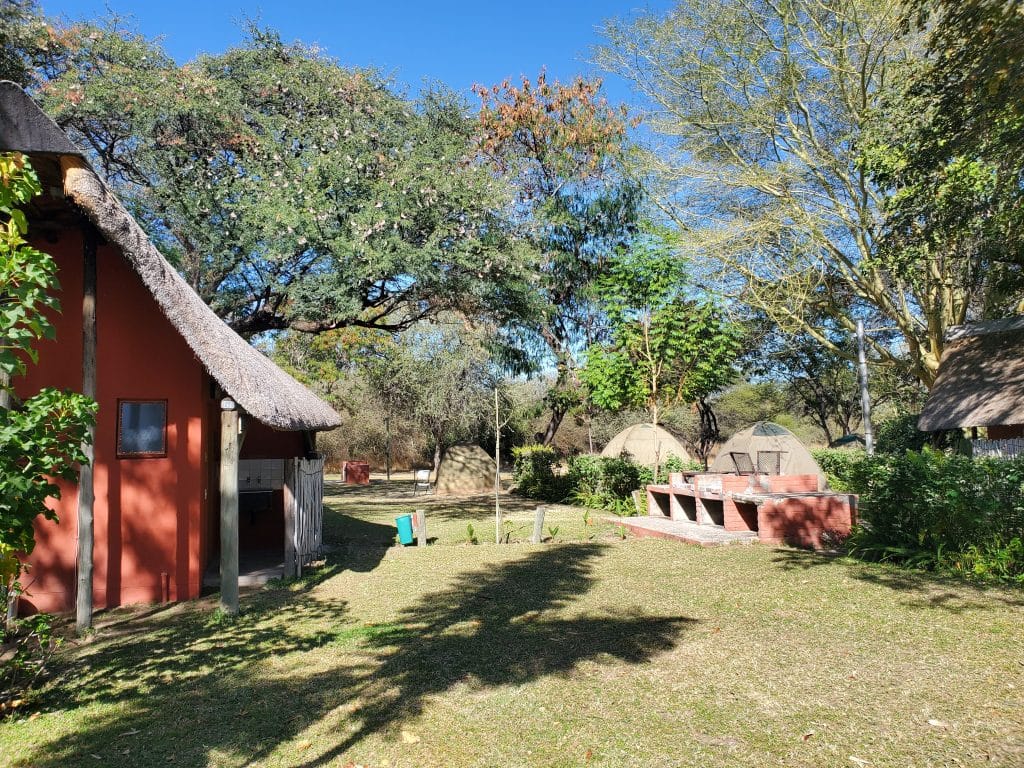
Ndhovu Safari Lodge, near Divundu
Ndhovu Safari Lodge is ideally placed to explore the three core areas of Bwabwata National Park (Mahango, Kwando, and Buffalo). The campground is located about 10 minutes away from the Mahango entrance and just across the Cuando River from the Buffalo Core. Learn More: Exploring the Caprivi Strip with Kids
Imagine waking up, sipping a hot cup of tea, and watching the Cuando River sparkle in the morning light. The sounds of distant splashes and grunts filled the air, and across the river, you see a bloat of hippos bobbing in and out of the water, making their way onto land to graze and sunbathe. This was our experience at Ndhovu Safari Lodge.
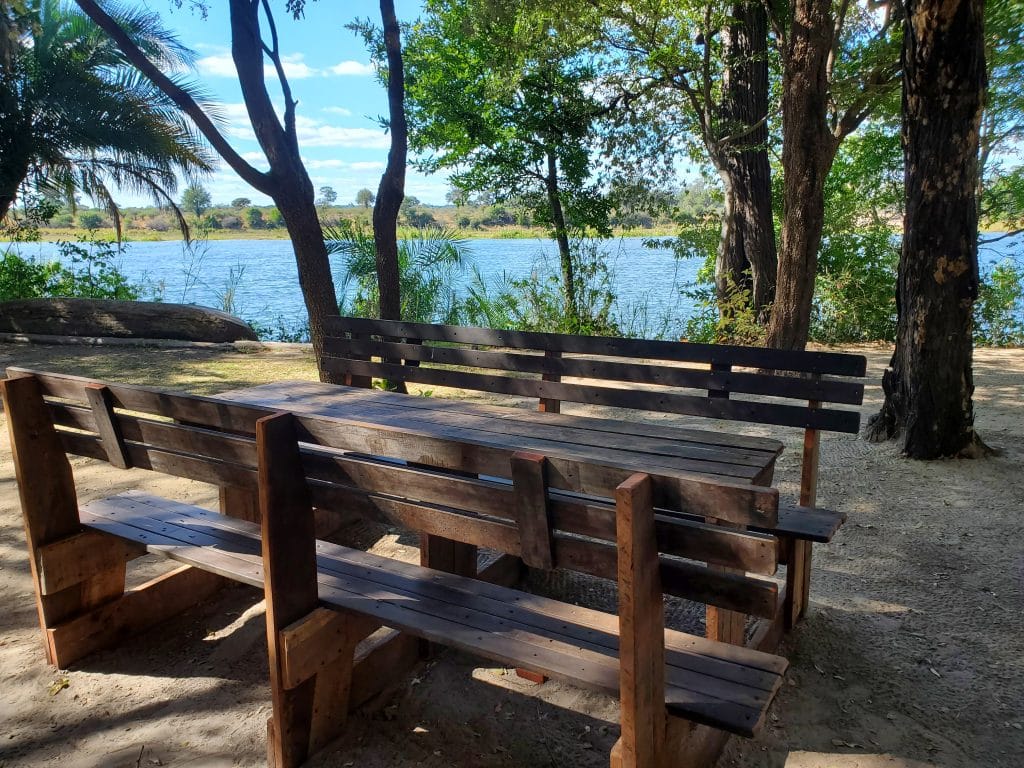
Ndhovu Safari Lodge offered spacious campsites with river views and beautiful leafy trees providing plenty of shade and privacy. Each campsite included a small fire pit and a covered wash area for dishes. There were two private bathrooms and shower rooms with hot water on demand. Wi-Fi was available at the reception/restaurant area. Laundry service was also available for a fee. For the kids, there was a pool and two adorable dogs to befriend.
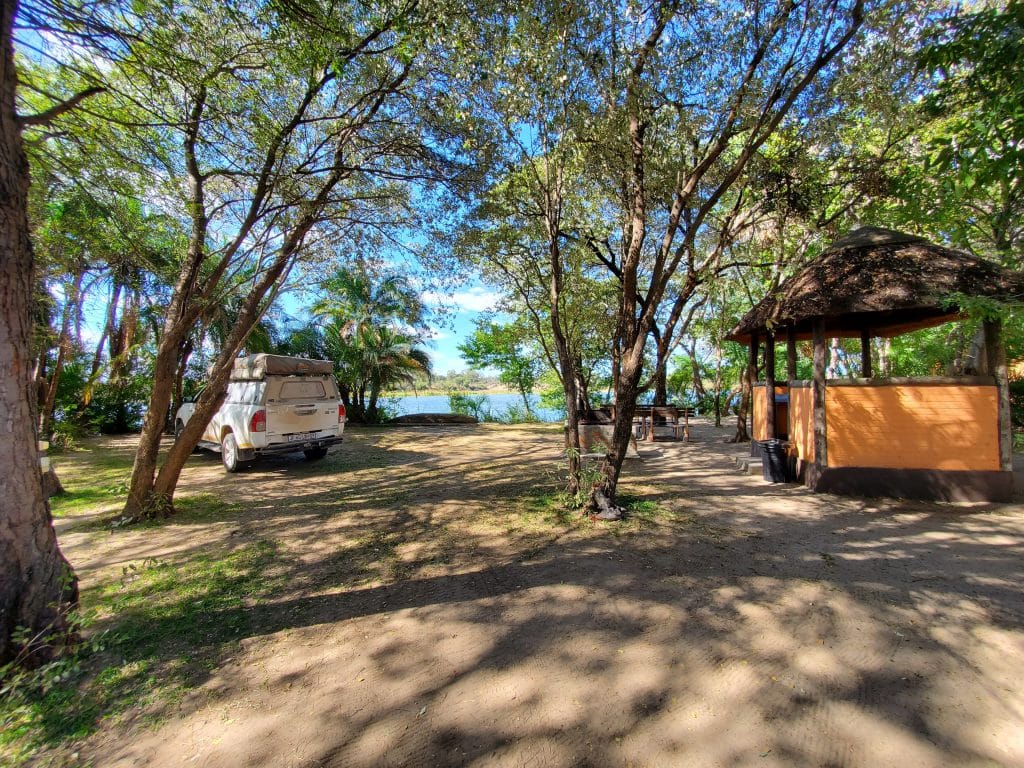
Safety Tip: Hippos are known to wander through the campsites from dusk to dawn. Beware when walking at night. They are territorial and can be highly dangerous if they feel threatened. More people are killed by hippos each year than by any other animal in Africa. Never get between a hippo and the water.
Livingstone’s Camp, Nkasa Rupara National Park
Livingstone Camp is located on the edge of Nkasa Rupara National Park. Known for it’s wild terrain and abundance of wildlife, Nkasa Rupara National Park is a great stop for those travelling through the Caprivi Strip.
Learn More: Exploring the Caprivi Strip with Kids
Finding Livingstone Campground was challenging due to poorly marked roads and missing signage, which caused us to backtrack in search of the GPS signal. After a few detours, we arrived at a stunning campsite that opened to a vast grassy plain—perfect for game viewing. Just set up your chairs around the fire pit and wait for the animals to come to you.
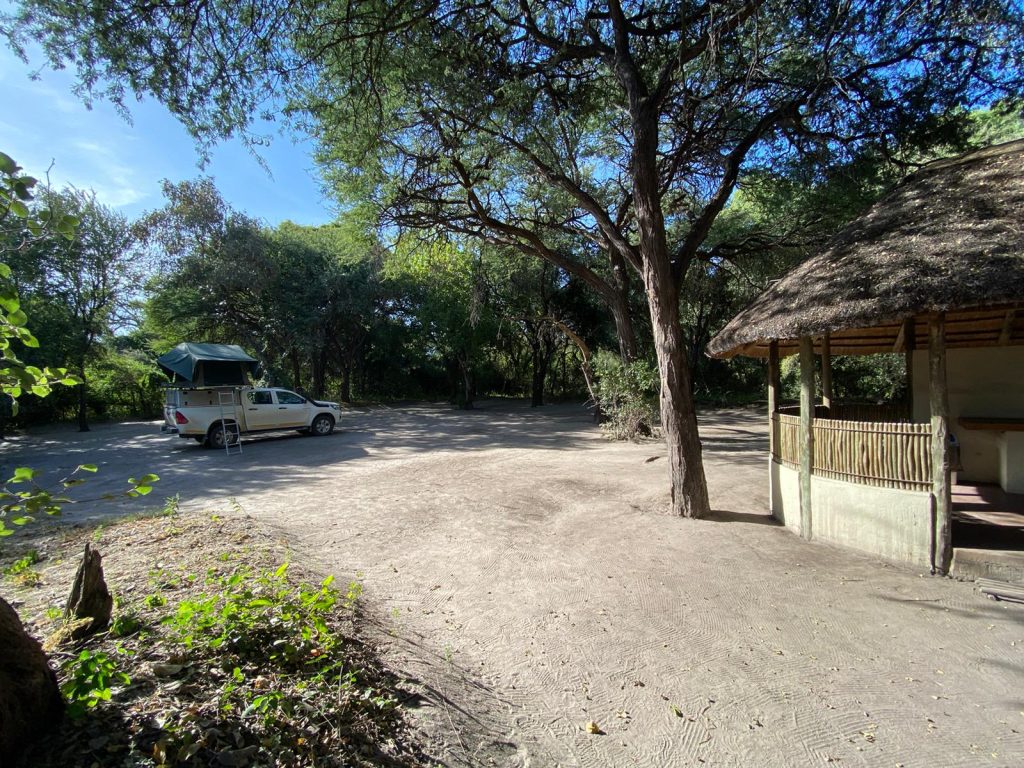
This private campsite offered a large, covered patio with a wash sink, outdoor seating, and a bathroom with hot water on demand. Solar panels powered the site, so lights and plugs were available to charge cameras and other electronics. There was no Wi-Fi. The park was unfenced, and animals, including hippos, elephants, and lions, were free to roam in and out of the campsite.
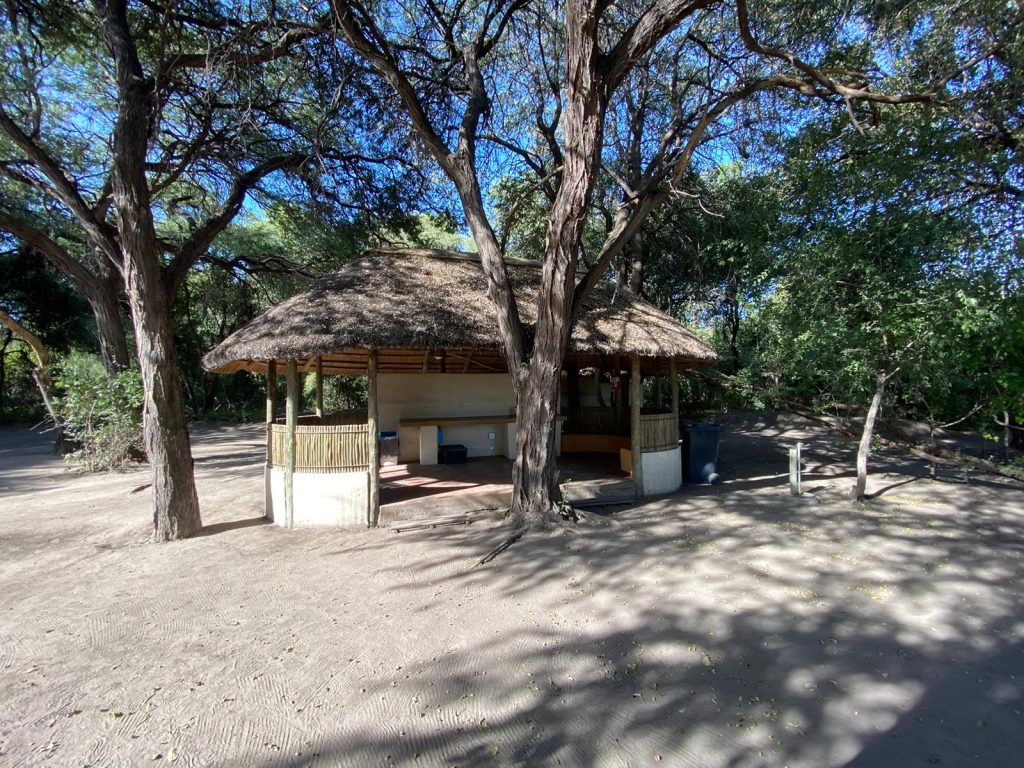
Caprivi Houseboat Safari Lodge, Katima Mulilo
Katima Mulilo is the largest city in the Caprivi Strip and the closest to the Zambian border. As you enter Caprivi Houseboat Safari Lodge, it feels like you’re entering a jungle. Towering trees with dense canopies, thick vines in various shades of green, and large-leafed bushes block out much of the sunlight along the path.
The reception was the perfect place to rest and soak in the beauty of the Zambezi River. From here, you can easily spot crocodiles and hippos lounging near the banks.
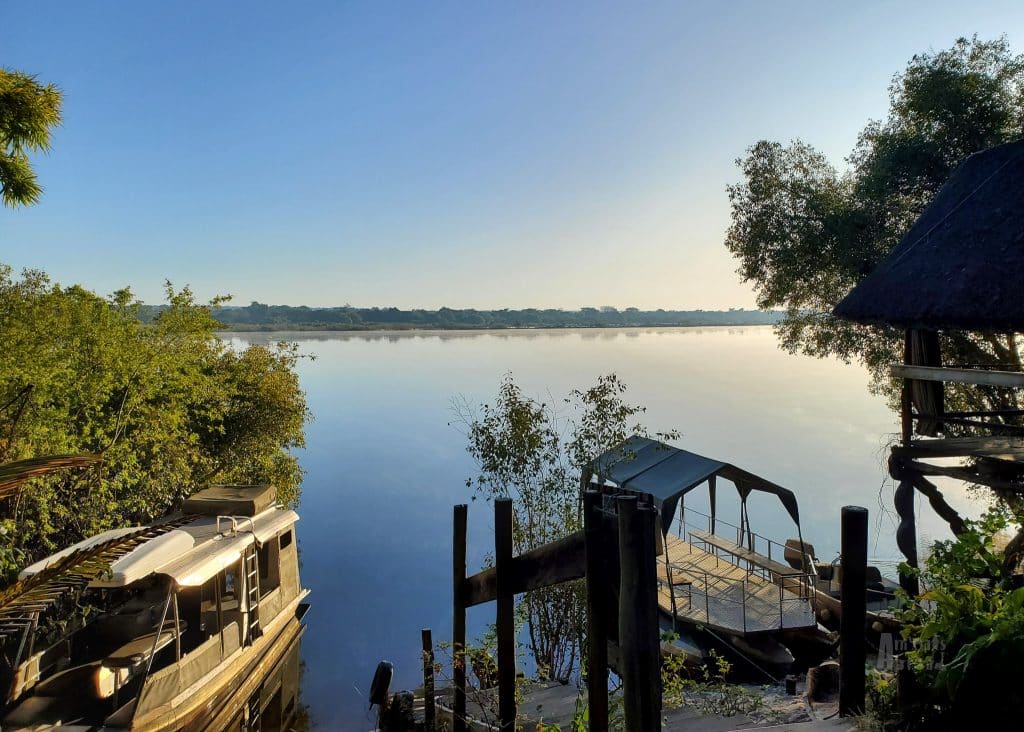
Tall straw stalks marked the boundaries of individual campsites at Caprivi Houseboat Safari Lodge, creating privacy. The sites were basic and equipped with a fire pit, power, and a wash sink. The camp provided firewood, and communal ablution facilities with hot water on demand were available. Wi-Fi was available at reception and reached the site.
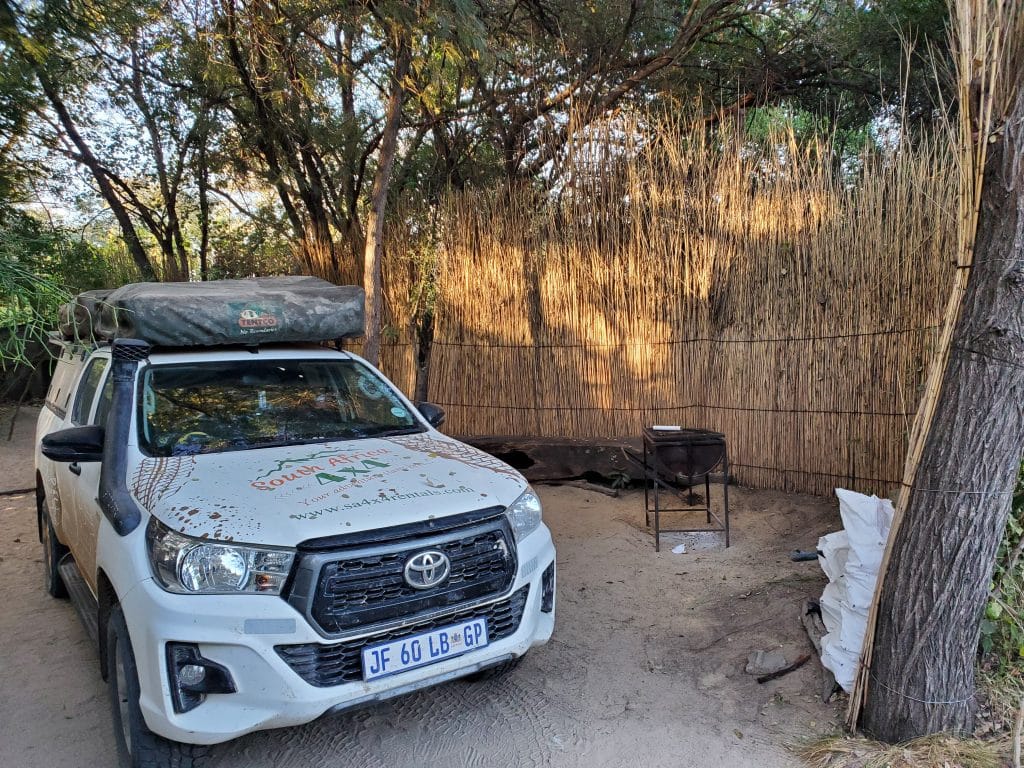
Zambia
Camp Nkwazi, Livingstone
Camp Nkwazi offers the best of both worlds, a relaxing camping atmosphere and proximity to Victoria Falls. Just 45-minute away, you can explore one of the largest waterfalls in the world and the main attraction in Livingstone. Situated on the Zambezi River, the falls separate Zambia and Zimbabwe, offering viewpoints from both countries.
Learn More: The Smoke that Thunders: A Trip to Victoria Falls
A small wooden bridge over a pond, nestled among lush vegetation, connects the Nkwazi campsites to the open-air bar and restaurant, and pool area. You can enjoy stunning views of the Zambezi River from the patio, where hippos are often seen and heard lounging on the beach across the way.
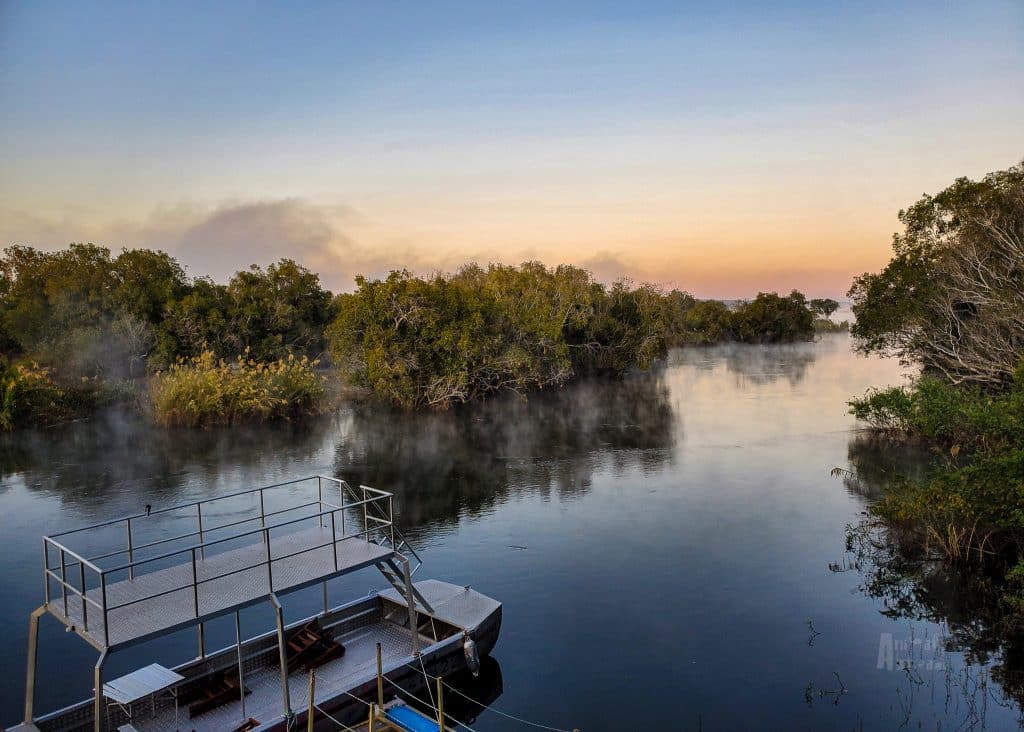
The campsites at Camp Nkwazi were spacious, with three sites sharing one large ablution facility. While we had the campsite to ourselves, it could feel crowded during peak season, as there was little privacy between the sites. The shower was one of the best we experienced on the trip, with steaming hot water on demand and excellent pressure. Each site was equipped with power, lights, a fire pit, and a wash sink. For those looking to relax, there was a pool with lawn chairs. Wi-Fi was available at reception, but the signal reached the campsite intermittently. The campground was fully fenced, ensuring no risk of hippos entering at night.
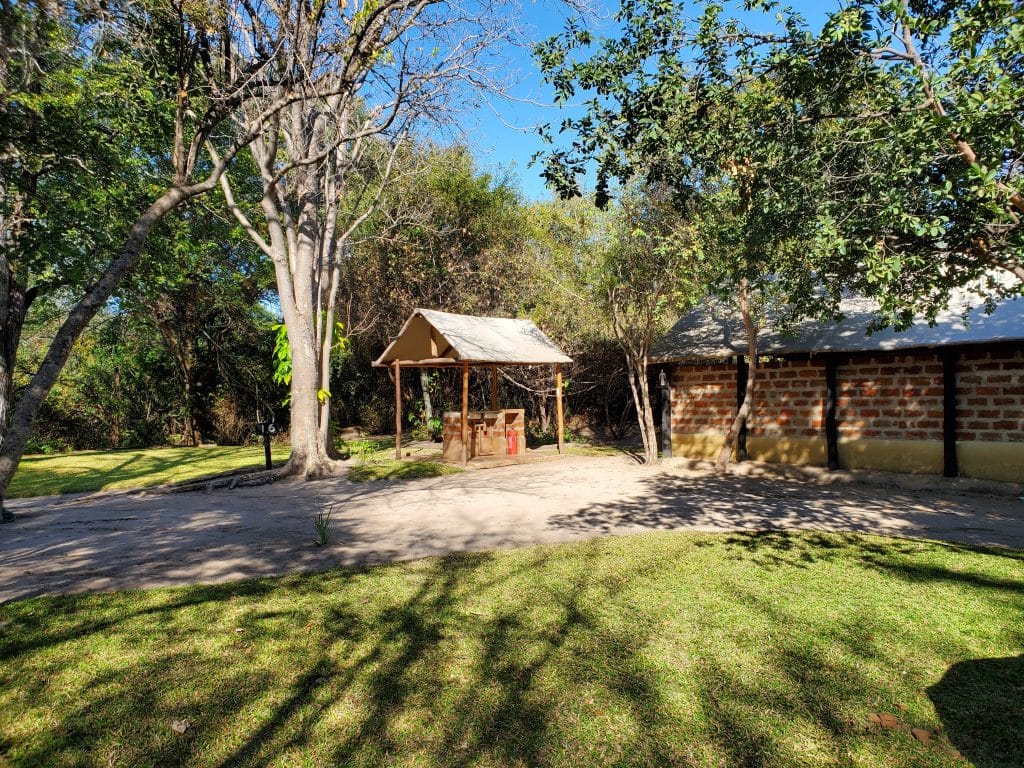
Botswana
Botswana’s National Parks have intentionally remained rural. This allows for some of Africa’s best viewing opportunities because the animals roam free. As such, there is always the possibility of animals wandering into the campgrounds to join you. We saw many animals in and around our campsite and even more pawprints when we climbed down from our tents in the mornings.
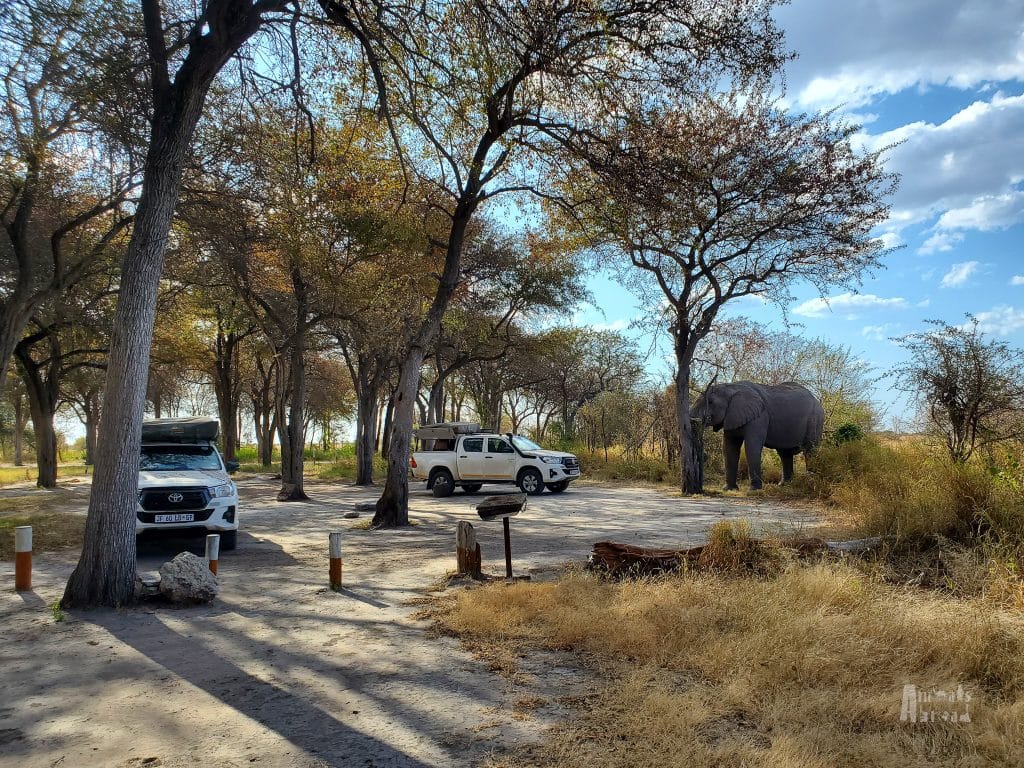
Chobe Safari Lodge, Kasane
Chobe Safari Lodge is located in Kasane, a bustling town near the Zambia-Botswana border. The main attraction of the campsite was the Lodge, located only a short walk from the camping area. Perched on the edge of the Zambezi River, the Lodge features an open-air restaurant and patio, along with a large pool and lounge chairs perfect for a relaxing afternoon while soaking in the views.
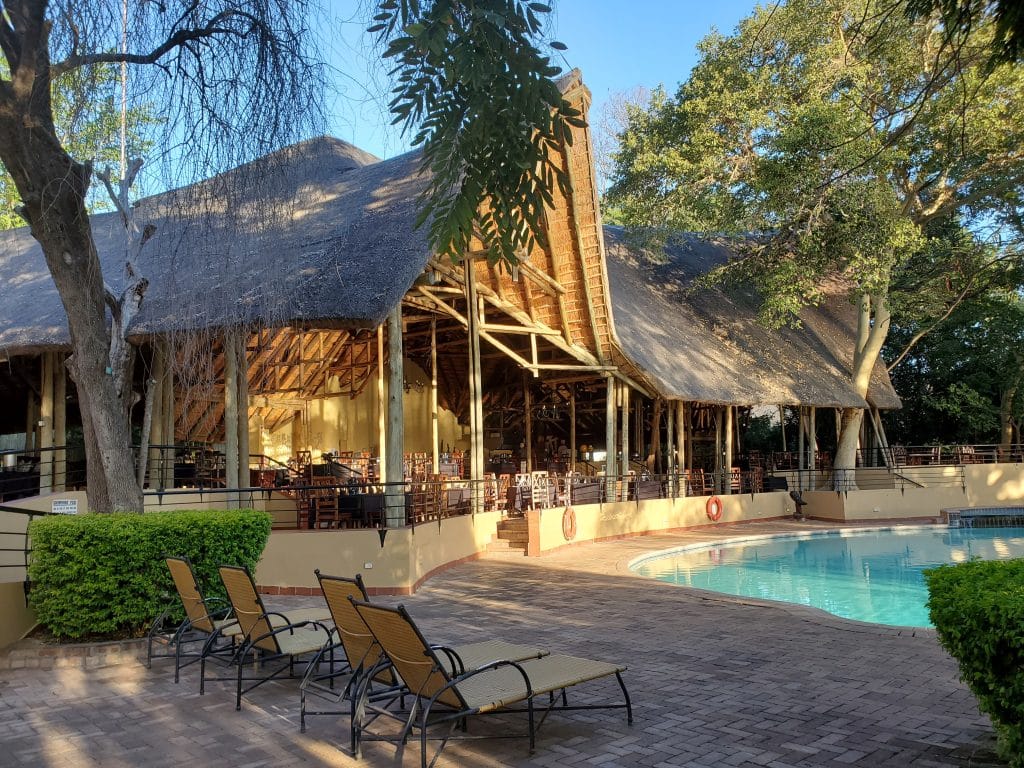
The campsites at the Chobe Safari Lodge were small and packed closely together, with limited privacy. There was no water on-site, but communal sinks were available for cooking water and dishwashing. Each site was equipped with power and lights, with electric plugs available for charging devices. Wi-Fi was accessible at reception. Chobe National Park is just a few minutes away, and the Lodge offered a variety of wildlife experiences, including land, boat, and helicopter tours. Self-drive, guided, and private safari options were available.
Learn More: Sunset Cruise on the Chobe River
Linyanti Campground, Chobe National Park
With a woodland landscape, Linyanti features lush floodplains and lagoons. It’s home to a large concentration of lions, leopards, and wild dogs. The area is also famous for its massive elephant population, which migrates along the Linyanti River during the dry season.
The campsites in Linyanti overlook the vast marshlands where elephants frequently visit to graze and cool off. For the best wildlife sightings, pull up a camping chair and wait for the animals to come to you.
Learn More: Camping in Chobe NP & Moremi Game Reserve
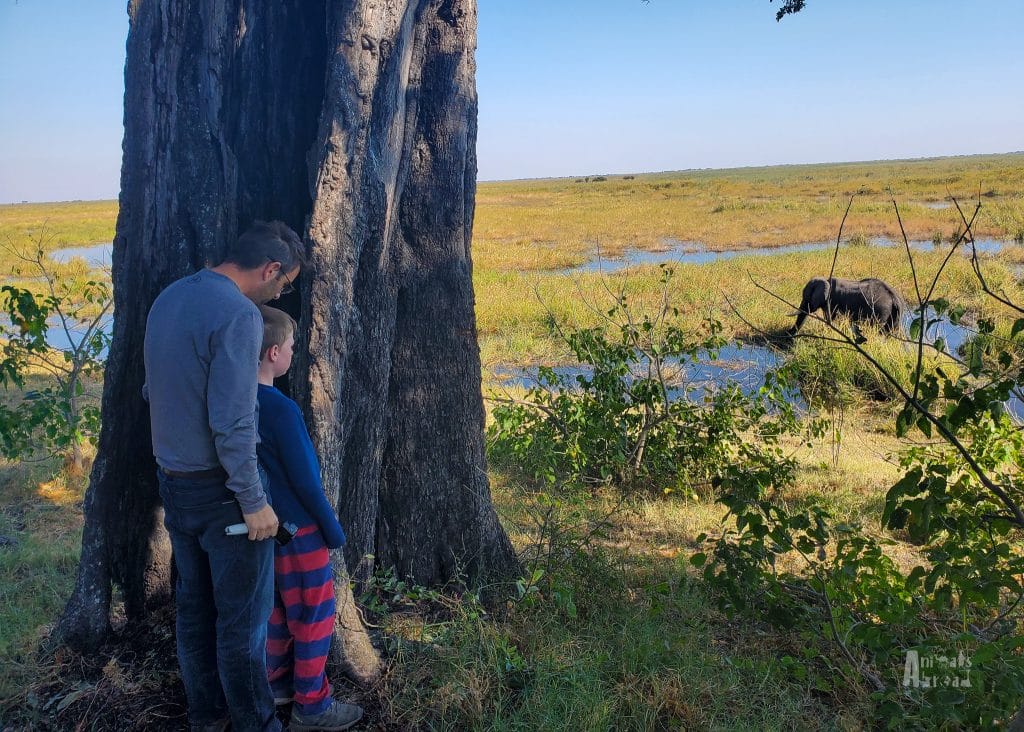
The sites at Linyanti were large and private, surrounded by trees, with views over the floodplains. It felt like we were the only campers there. Water was available on-site, but there was no power. The ablution facilities were clean, although hot water for showers was inconsistent—there was no hot water during our three-day stay. There was no Wi-Fi, restaurant, lodge facilities, or guided game drive.
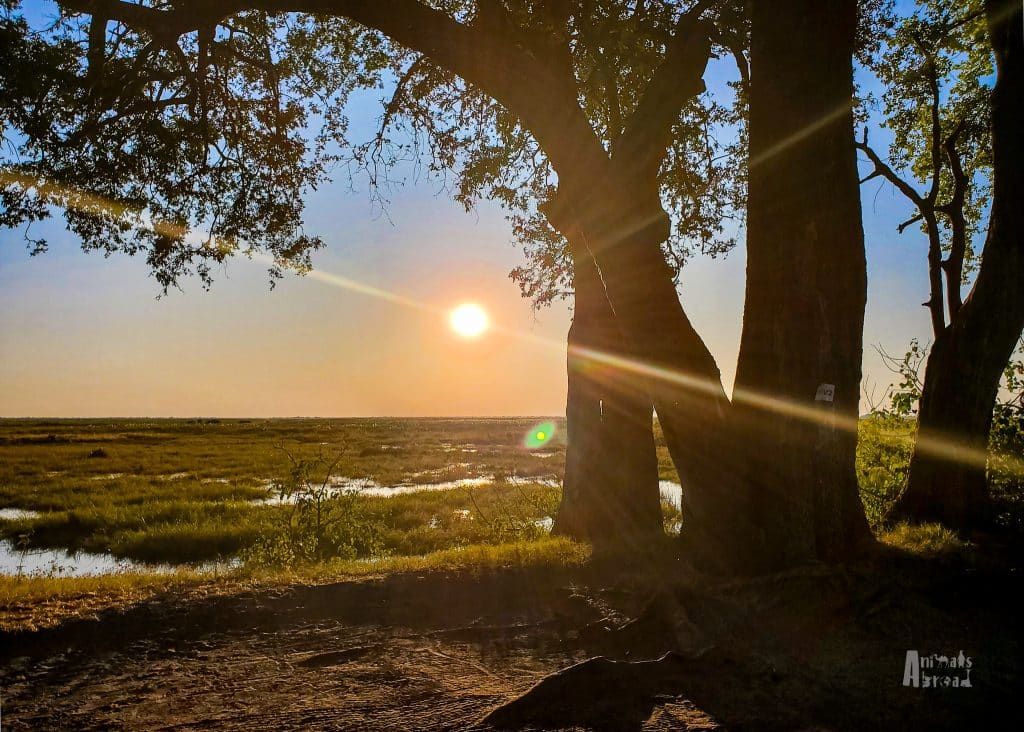
Safety Tip: Baboons are common in the area. When you leave camp, ensure you put your tent down and leave nothing outside. Lions are known to enter the campground at night—we saw many paw prints around our truck in the morning. Avoid walking to the ablution stations after dark. Elephants roam the camp at all hours—some can be aggressive, as poaching is still a concern in this area.
Savuti, Chobe National Park
The Savuti area is vast, with various terrains, from forested areas to open grassy savannahs with waterholes. Several trails take you close enough to observe and photograph the game.
Learn more about our experiences, Into the Wild: Chobe NP with Kids
The Savuti campsites were large and shaded by trees but close together, with limited privacy. Water was available on-site, but there was no power. The deep sand on the sites made setting up our tent ladder tricky, and it felt like we were camping on a beach. The ablution facilities were clean, with multiple showers and toilets. Hot water was available, though intermittent. Laundry services and wash sinks were available for self-laundry. A restaurant and lodges were on-site, and Wi-Fi was available at reception.
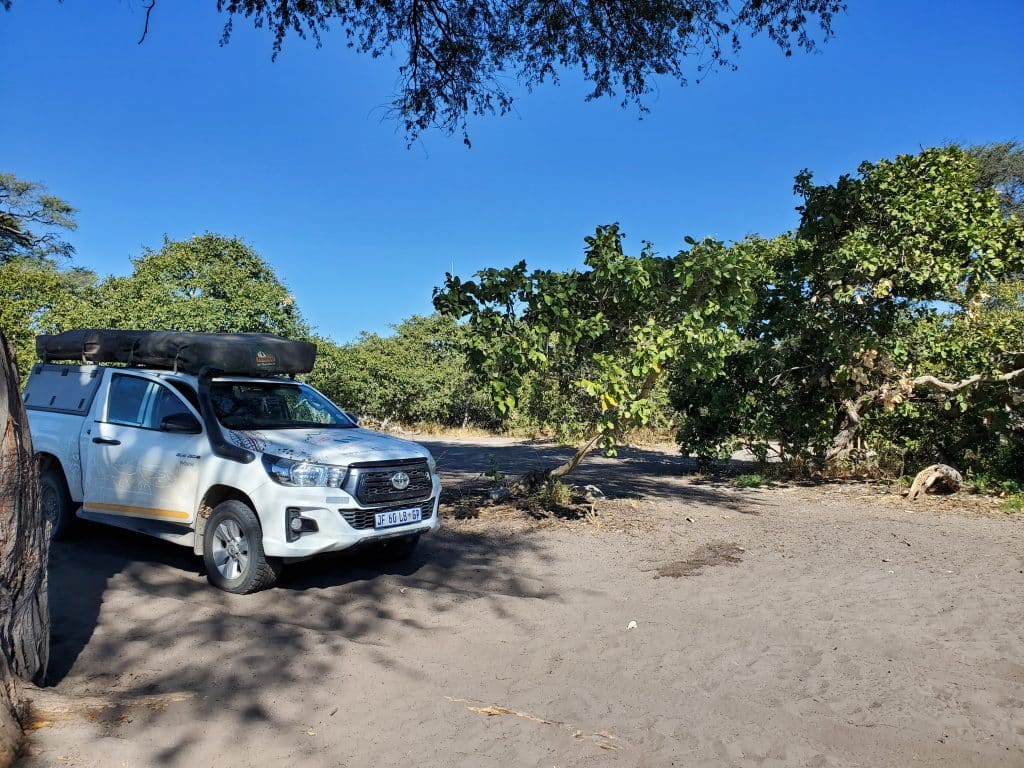
Safety Tip: Unlike in Namibia, Botswana’s campsites are open, meaning animals roam freely. If your campsite is far from the ablution station, avoid walking at night, due to the possibility of game, including large cats, nearby. One evening, around dinner when the campground was still lively, Derek and Mason spotted a leopard crouching in the bushes about 15 meters away, while walking to the bathroom. We later learned that the same leopard had passed through a neighbouring campsite just moments earlier.
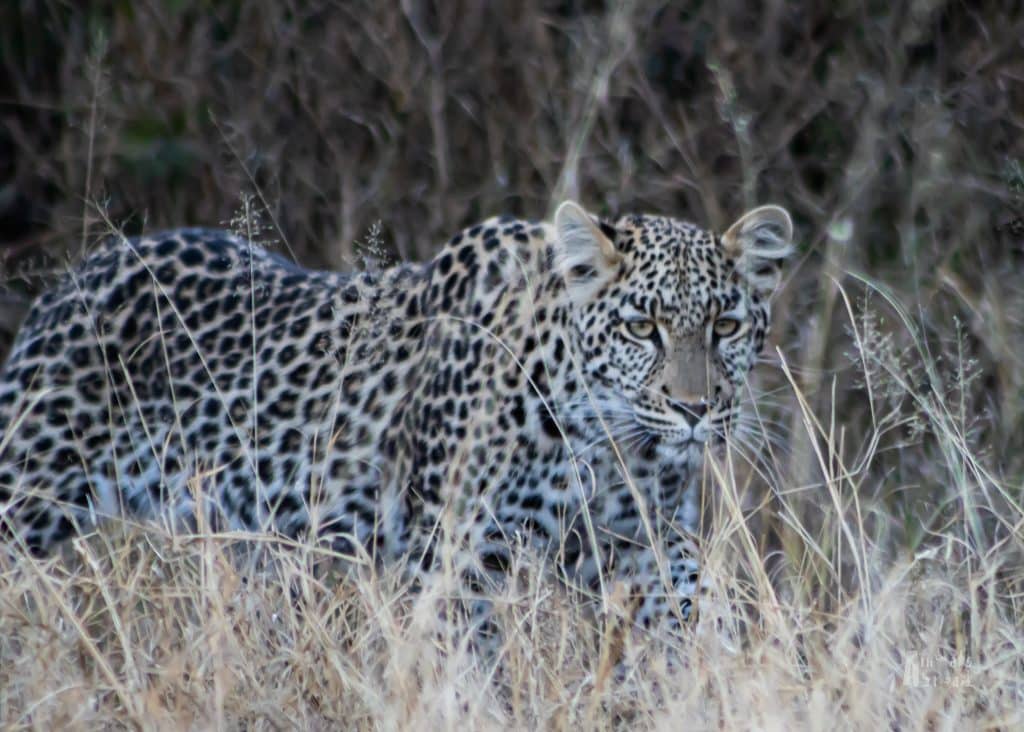
Khwai, Moremi Game Reserve
Moremi Game Reserve offers the chance to see some of Botswana’s most endangered species, including wild dogs and both white and black rhinos. The beautifully diverse landscape features grasslands, forests, floodplains, and lagoons. Unlike national parks, Moremi is designated as a game reserve and is home to the BaSarwa people.
The Khwai campsites, like those at Linyanti and Savuti, are part of the same chain (SLK), though Khwai is in a different park. The campsites were well-spaced, shaded with trees, and offered plenty of privacy. Water was available onsite, but there was no power. The ablution facilities were clean, with multiple showers and toilets. Hot water was available intermittently. No lodges or restaurants, and no Wi-Fi, or guided game drives available.
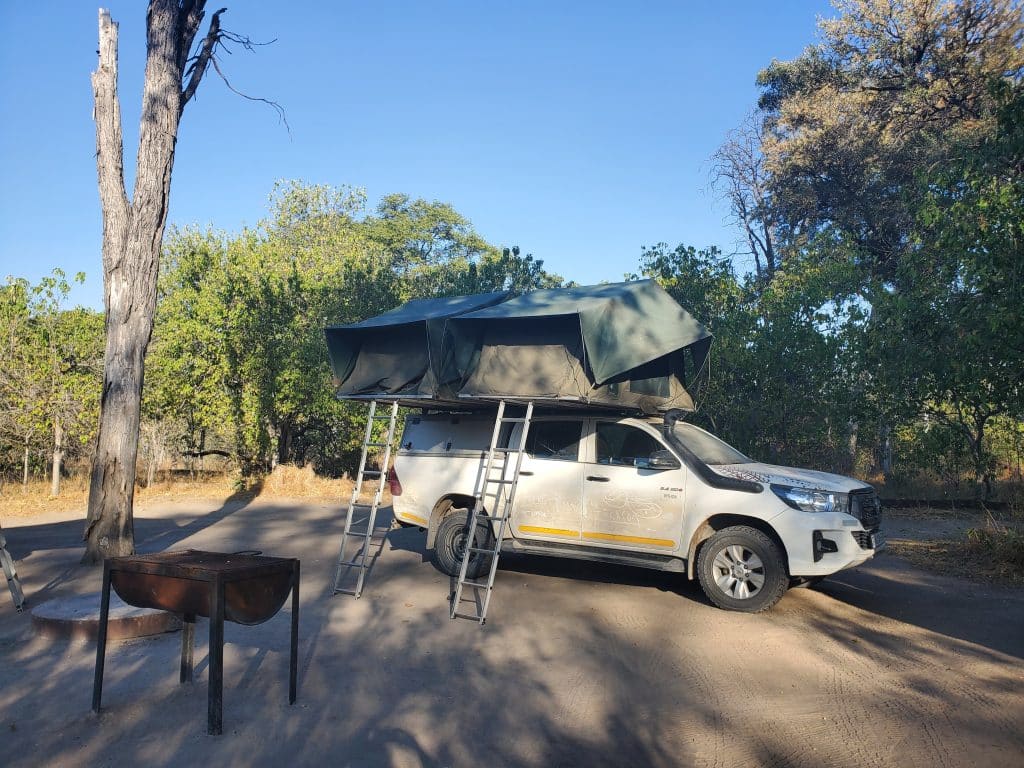
Safety Tips: Be cautious of curious monkeys that will surround the campsites when food is out and will attempt to steal anything they can. Driving to the ablution stations after dark was recommended, no matter how close your campsite is to the facility, as lions prowl the campground at night. We did not see any lions; however, one night, just as we were about to get out of the truck to get ready for bed, we turned on the headlights to find a large spotted hyena lurking in front of us. It quickly vanished into the brush when the lights came on.
Mankwe Bush Camp (Just outside of Moremi Game Reserve)
Mankwe Bush Camp is where luxury cabins and basic campsites meet, offering the best of both worlds. Upon arriving at the reception, you’ll feel like you’ve stepped into an oasis. Rustic wooden bridges guide you through the resort, leading to two pool decks with padded lounge chairs, personal towels, covered sitting areas, bars, a restaurant, and a reading room. A small watering hole next to one of the pools provided an opportunity to watch wildlife while lounging in the sun.
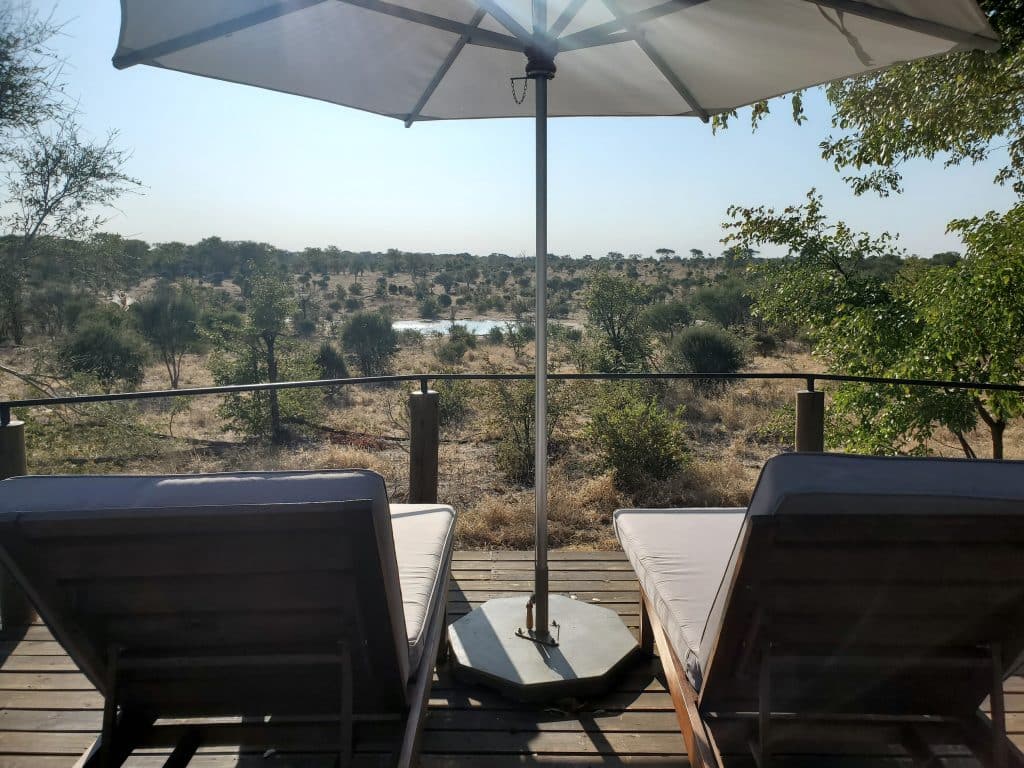
But, just a five-minute drive down the road, you’re in complete wilderness, with only basic camping amenities. The campsites are widely spaced, creating a sense of solitude and immersion in nature.
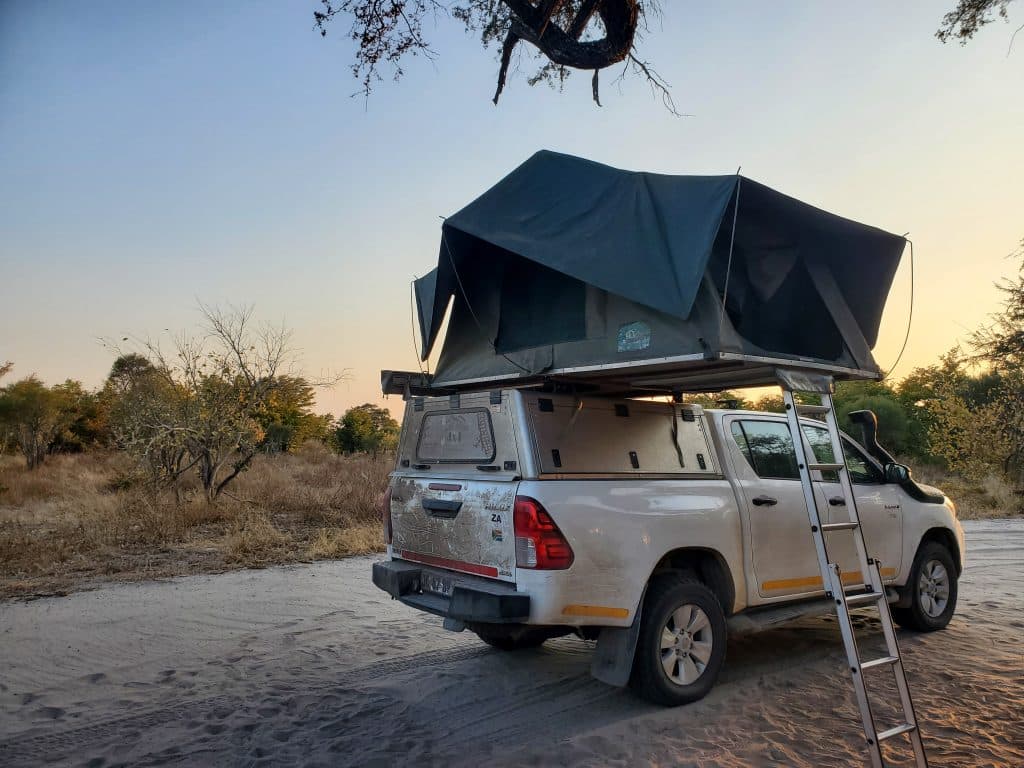
The Mankwe Bush camping area is situated in the middle of a grassy savannah. Each site had a private tented ablution facility with a bag system shower. To use it, you boil water and mix it with cold water to achieve the desired temperature, then open a lever to allow the water to flow. Fresh water isn’t available on-site—only saltwater—so you must bring your own drinking and cooking water. There is no power, but the reception offers a restaurant and Wi-Fi. The resort is not inside Moremi Game Reserve, so there are no additional park fees.
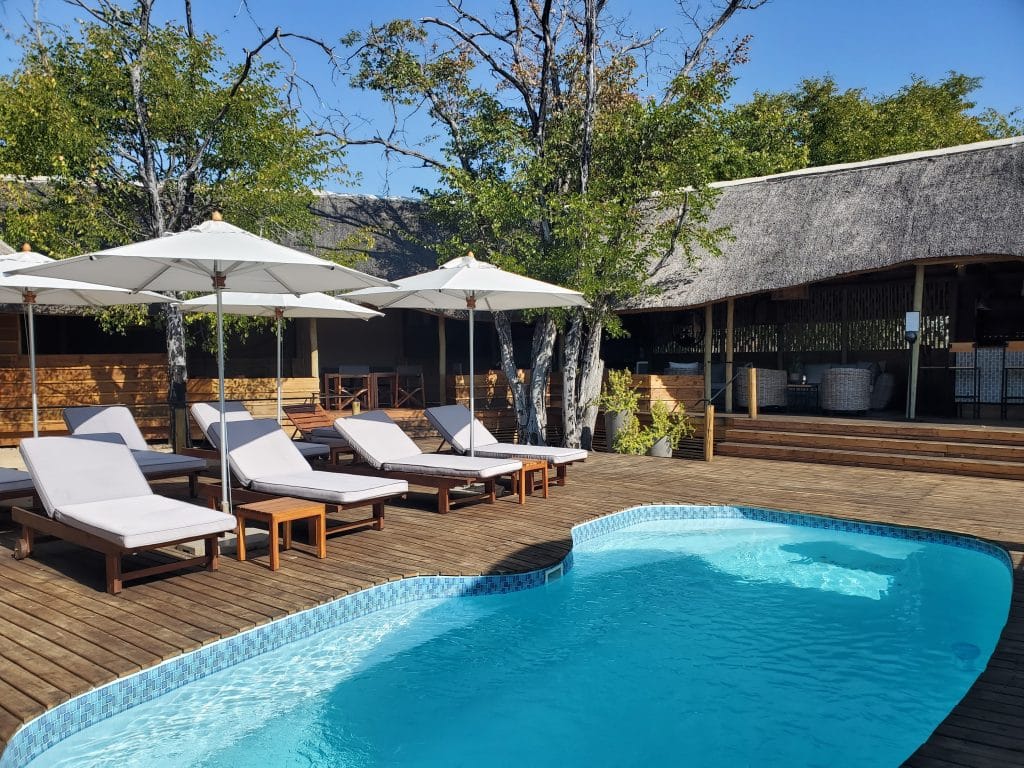
Crocodile Camp, Maun
Maun, a larger city, has several grocery stores, banks, and repair shops making it a great place to stock up on essentials.
The Crocodile Camp is perfect for those seeking seeking creature comforts during their safari. With lodges, a restaurant, two bars, a pool, a spa, and a gym, it was a perfect place to unwind and rejuvenate for a few days. The pool, bar, and restaurant area overlooked a small river where you could watch cows leisurely graze.
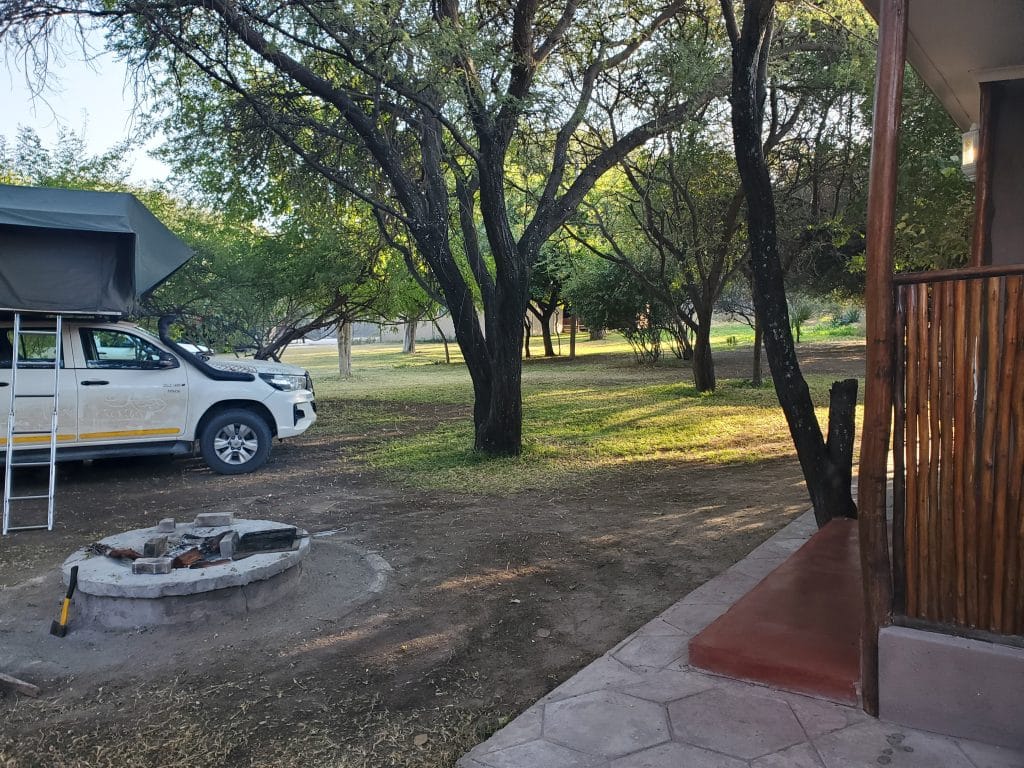
Each campsite, at the Crocodile Camp, had private shower and toilet facilities, a covered patio with a washing sink, deep laundry sinks, and a clothesline. While the campsites were very close together, offering little privacy, the amenities made up for it. Water and power were available on-site, with hot water on demand. Wi-Fi reached the campsite. Campers can use all the services, including the restaurant, spa, and gym.
Baines Baobab Campground, Nxai Pan National Park
Nxai Pan National Park, located southeast of Chobe National Park and Moremi Game Reserve, was one of our most stunning areas. The Makgadikgadi Pans are a vast collection of salt flats rivalled only by Bolivia’s famous Uyuni Salt Flats. With ancient Baines Baobab trees and incredible landscapes, Nxai Pan National Park will surely create lasting memories.
Learn More: Living Giants: A Photo Journey Through Nxai Pan National Park
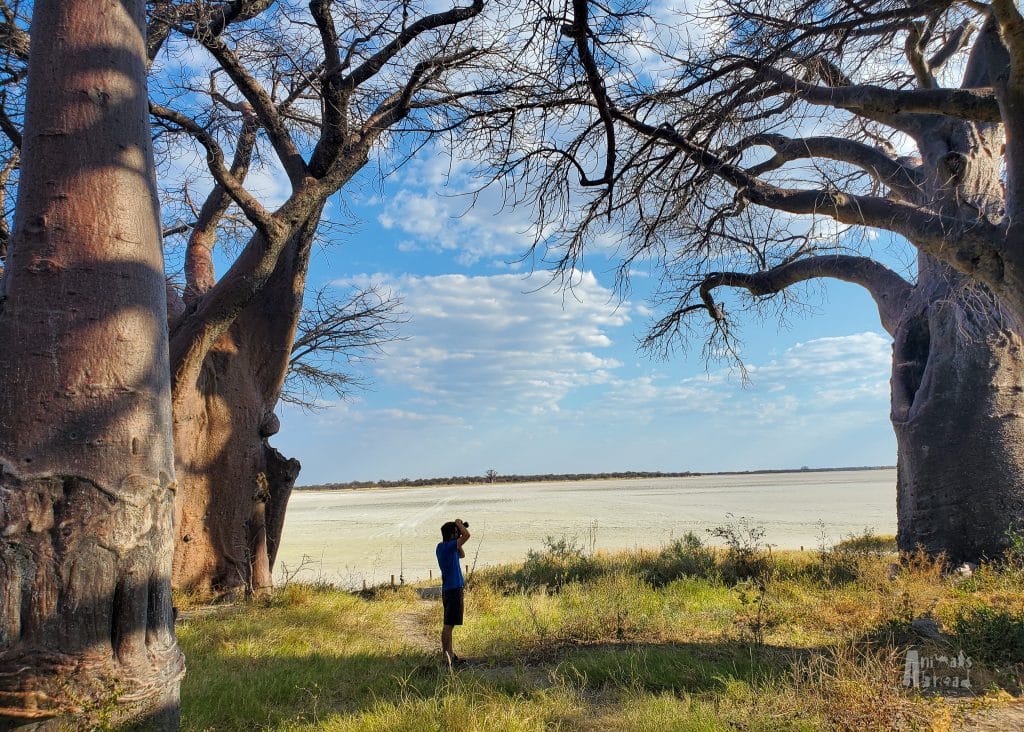
Nxai Pan Baines Baobab Campground was one of the most beautiful campsites we stayed at. However, it was basic and equipped with an outhouse, an outdoor bucket shower, and a single fire pit. There was no power, lights, running water, garbage pick-up, or Wi-Fi.
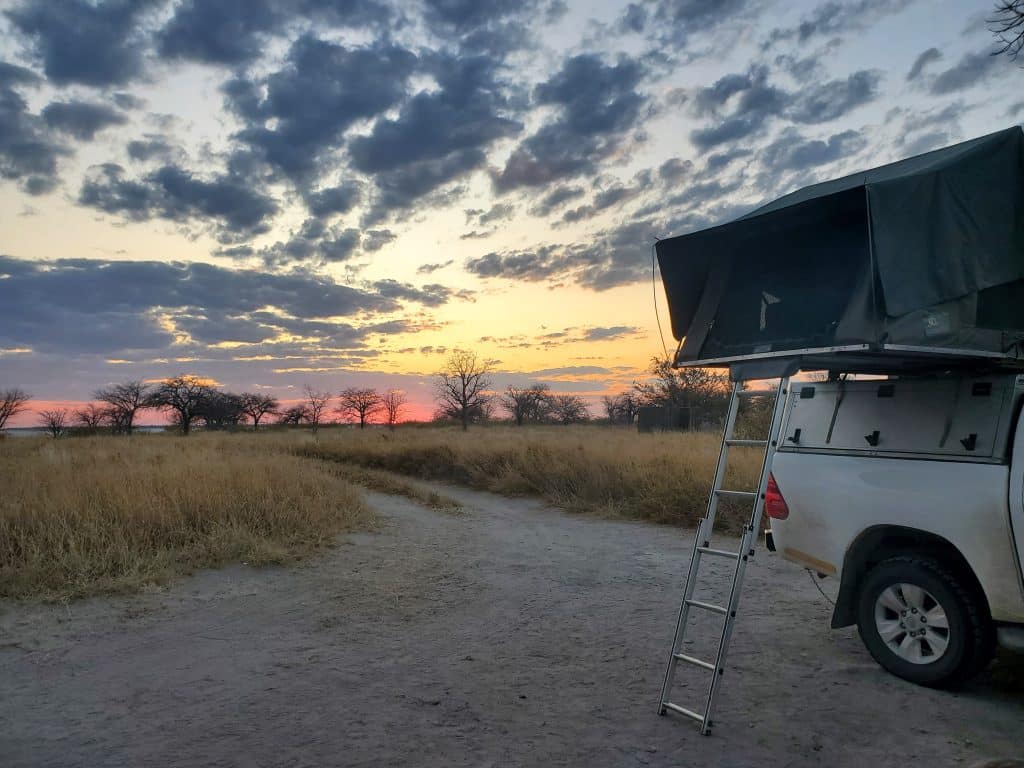
South Gate Campground, Nxai Pan National Park
The South Gate entrance to Nxai Pan National Park offers a remarkable wildlife experience and is known for its active waterholes, attracting a wide variety of species throughout the year, including large herds of elephants, giraffes and, if you’re lucky, lions.
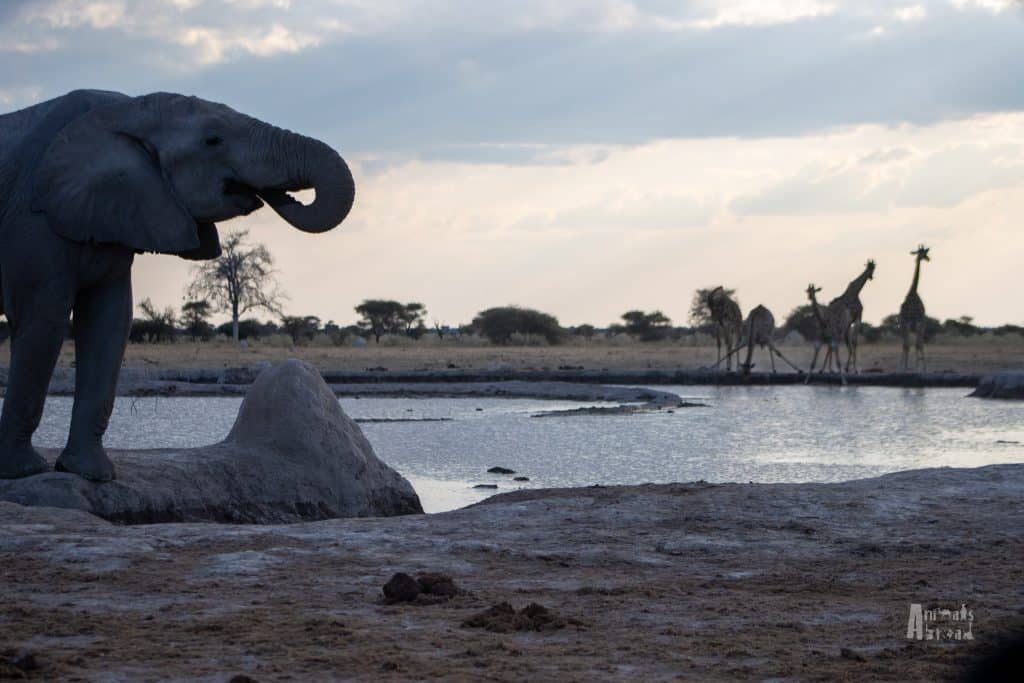
Driving Time: 2 hours.
Roads: Compact dirt roads full of potholes and uneven terrain.
Campground: South Gate
This campground had limited privacy and no power, lights, or running water. However, there are nearby ablution facilities with toilets, hot water for showers, and large sinks for dishes. There was no Wi-Fi. The upside of staying at South Gate was the animal sightings. When we arrived, we were greeted by three elephants grazing next to the ablution facility. We spent over an hour watching them before one casually wandered through our campsite to another grassy area.
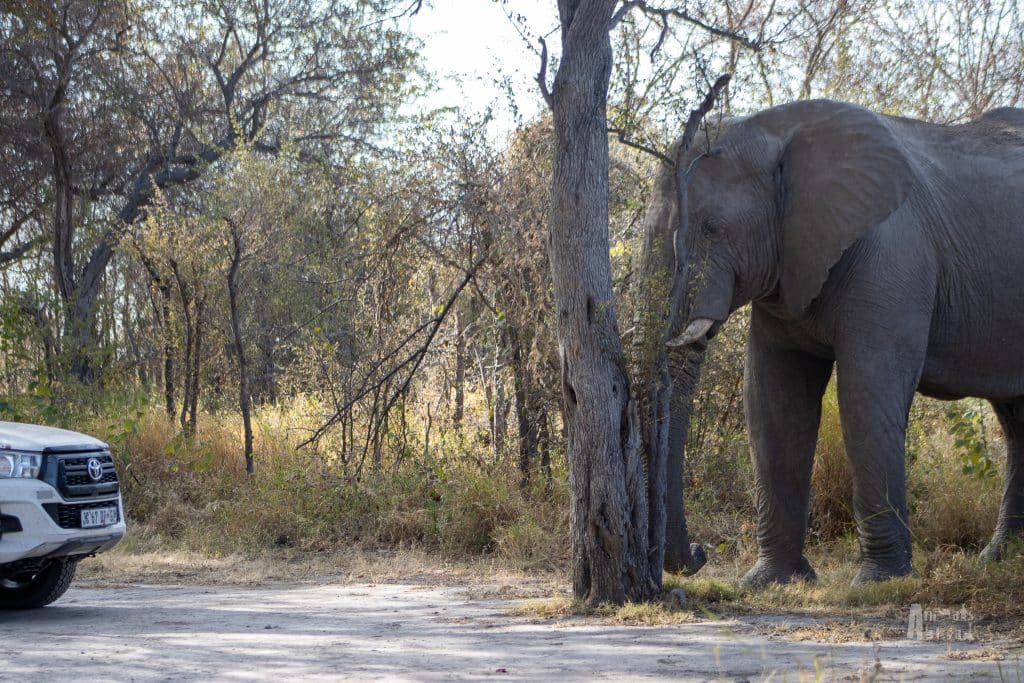
Elephant Sands Campground, Nata
Elephant Sands is famous for its incredible waterhole, which is located next to the campground. Throughout the day and night, families of elephants trudge back and forth to drink and cool off. If you’re fortunate enough to snag one of the campsites up front, you can set up your camp chairs and enjoy the show without moving.
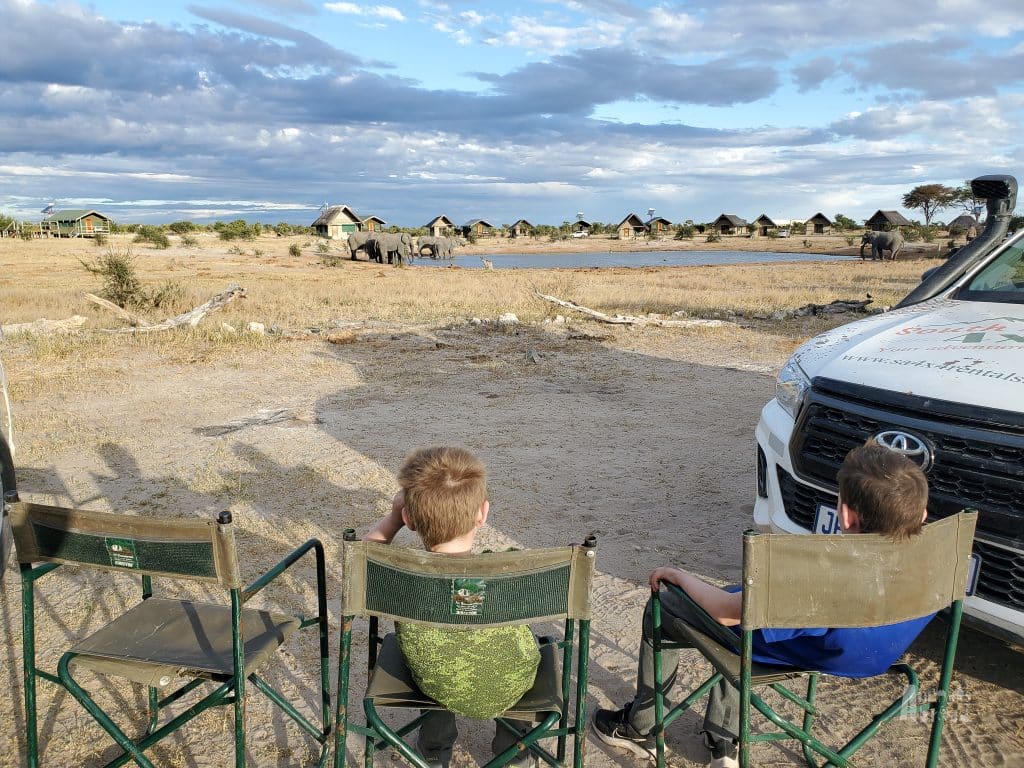
The campground at Elephant Sands was a large grassy field without clearly defined boundaries between campsites. It operated on a first-come, first-served basis. As a result, people often competed for the five campsites closest to the waterhole and squeezed into tight spaces to secure the best views. Don’t worry if you don’t get a prime spot. The restaurant area has an incredible viewing platform where you can still enjoy the wildlife sightings. The campsites had no water, power, or lights, and the ablution facilities were shared. Wi-Fi was available in the reception/restaurant area.
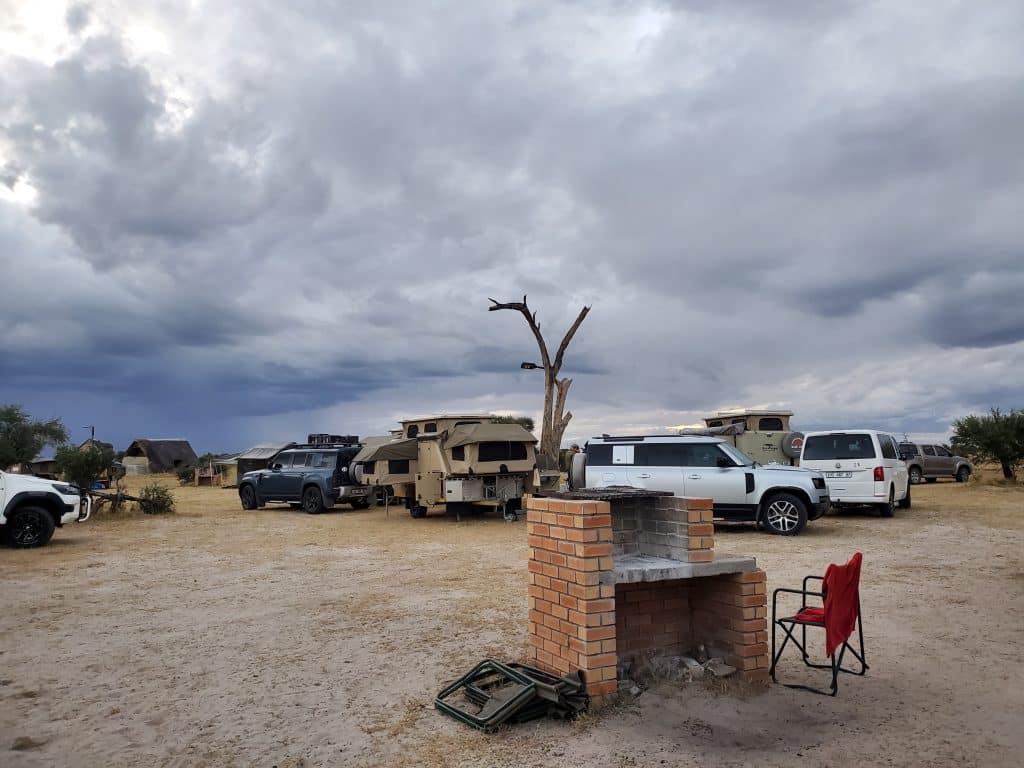
Limpopo River Lodge, Tuli
Limpopo River Lodge was a surprise, leaving us wishing we had more time to enjoy this serene campground. Large green trees provided ample shade and privacy, and the sound of the rushing river made for peaceful nights. Private bathrooms and showers with hot water were available nearby, and the river provided water for washing and cooking. Wi-Fi was intermittent at the campsite.
Safety Tip: Be cautious at night and early morning as hippos come out of the water to graze.
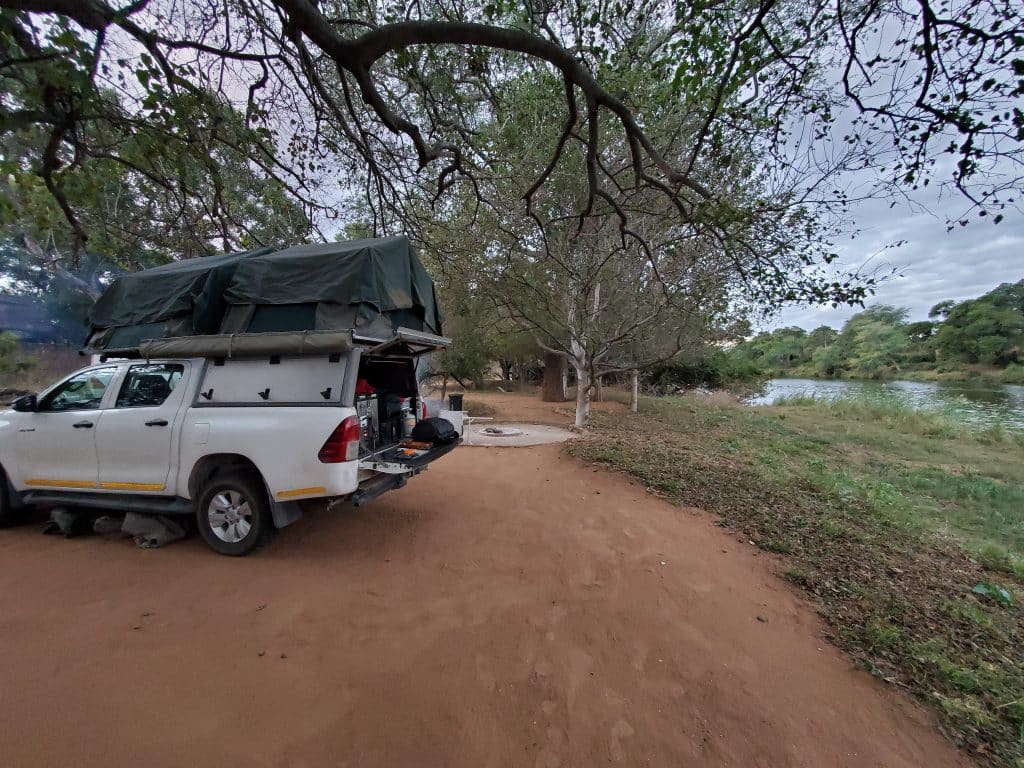
Klein Kariba Resort, Brits, South Africa
Klein Kariba Resort was indeed a resort! The enormous complex offered multiple accommodations, from camping to fully equipped cabins with TVs, kitchens, and bathrooms. There were several pools, including heated ones, waterslides, and playgrounds. Activities included horseback riding, golf, paddle boats, and an arcade. The ablution facilities were spacious, with showers and bathtubs available. There was a large restaurant, and Wi-Fi reached the campsites.
Each campsite had a tent for sun and rain protection; however, the sites were small and packed closely together. The campsite felt crowded, and the noise and lights persisted late into the evening. This is not a site I would recommend if you’re looking for a tranquil, nature-focused experience. It’s better suited for those seeking comfort and amenities, but it was far too busy for our liking.
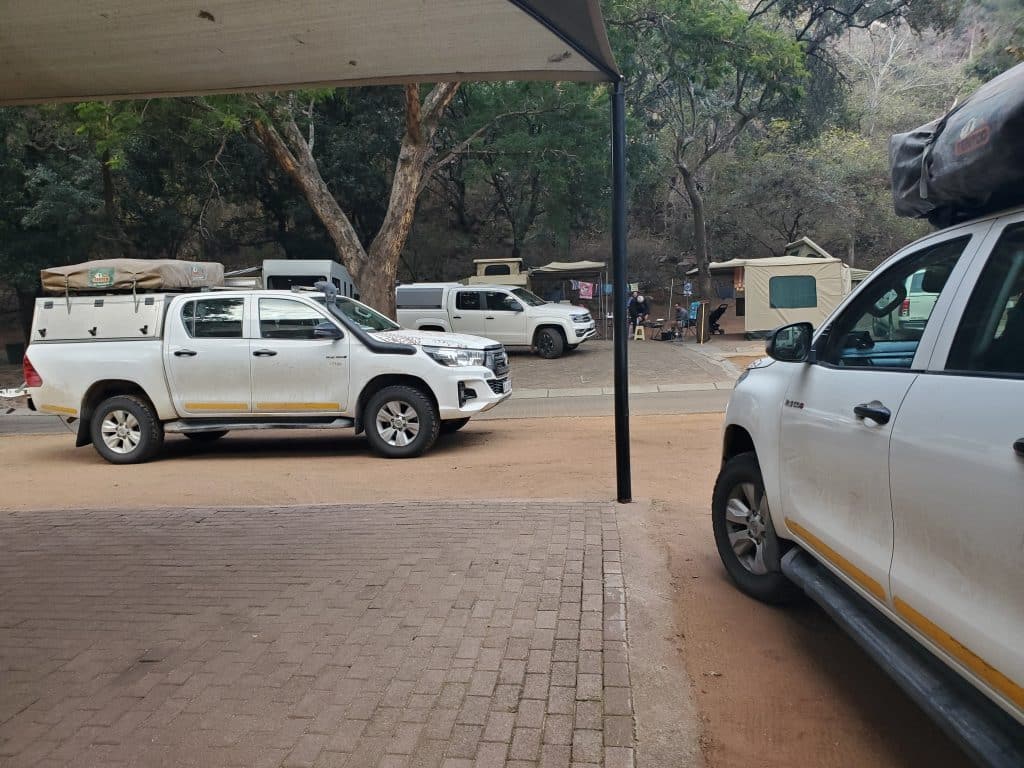
Ready to Create Your Own Wild Adventure?
Check out these related posts to help plan your trip:
- 51-Day Africa Safari – Part 1: South Africa & Namibia’s Coast
- 51-Day Africa Safari – Part 2: Namibia’s Etosha & Caprivi Strip
- 51-Day Africa Safari – Part 3: Victoria Falls & Botswana
- Our Best and Worst Day on Safari
- Camping Safari in Africa: Know Before You Go
- Navigating Border Crossings in Southern Africa
- Safari with Kids: Tips from the Road
- Etosha NP with Kids: A Family Safari to Remember
- Exploring the Caprivi Strip with Kids
- Okonjima Family Safari: Where the Wild Things Wait
- The Smoke that Thunders: A Trip to Victoria Falls
- Into the Wild: Chobe NP with Kids
- Sunset Cruise on the Chobe River: A Photo Journey
- Living Giants: A Photo Journey Through Nxai Pan National Park
